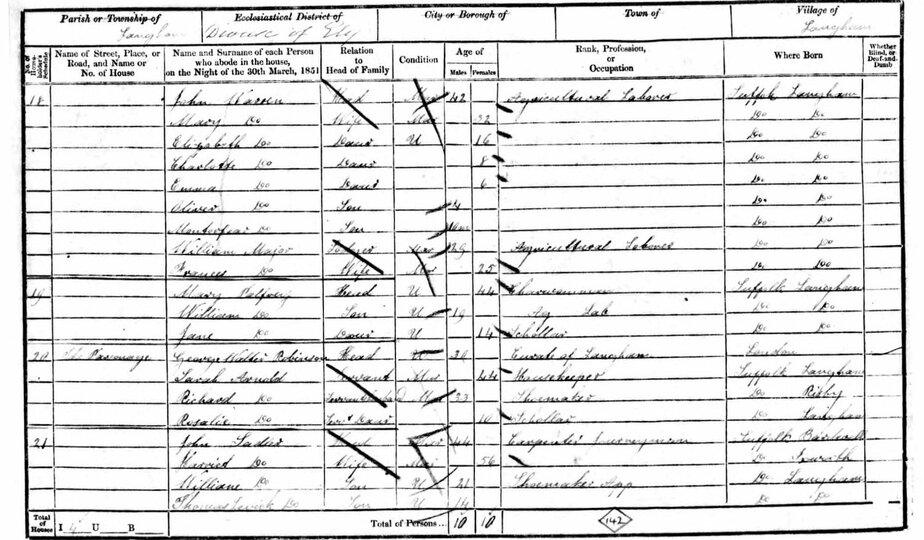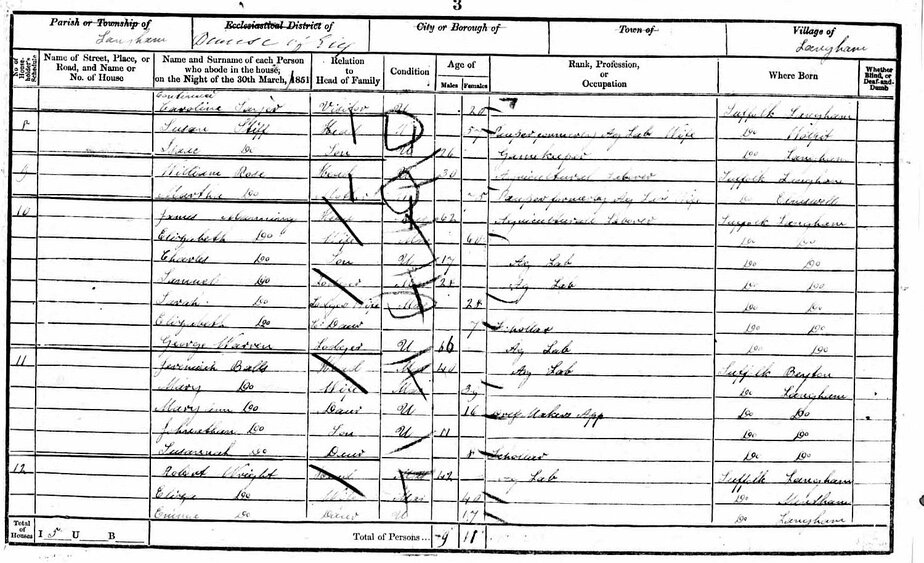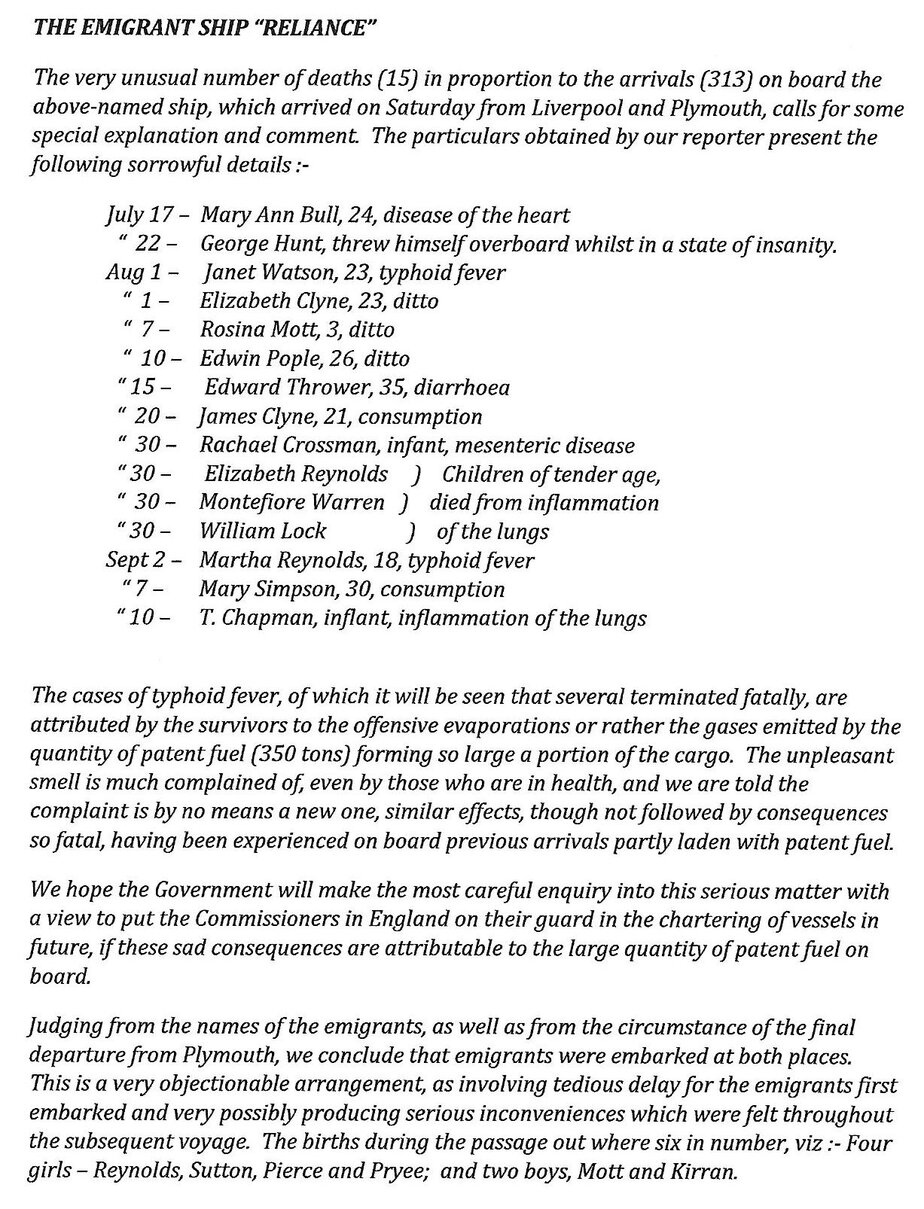John WARREN (C1812-1867) and Mary MANNING (1818-1899)
Family Stories > 5th GENERATION
John Warren (Abt 1810 - 1867)
Spouse #1 : Elizabeth Manning (1814 - 1837)
Spouse #2 : Mary Manning (1819 - 1899)
John Warren was the first of the Warren line in Australia
John Warren and Mary Manning were my Paternal 2nd Great-Grandparents - 5th Generation
1. Nola Irene Warren
2. .... George Ernest Edward Warren & Iris Ella Ford
3. .... .... Leonard Leslie Warren & Burdett Launder
4. .... .... .... Charles James Warren & Agnes McNay
5. .... .... .... .... John Warren and Mary Manning
JOHN WARREN Birth Between 1809 and 1811 in Suffolk, UK Father John Warren (from Marriage Certificate) Mother Unknown Marriage #1 1830, September 24 in Langham, Sufffolk Spouse #1 Elizabeth Manning Marriage #2 1840, March 6 in Superintendent’s Office, Bury St. Edmunds, Suffolk Spouse #2 Mary Manning (younger sister to Elizabeth Manning Witnesses to Marriage #2 Dorothy Nodes Wing and Mary Ann Rosier (or Rosien) Death 1867, June 21 at Happy Valley, SA Age at Death 59 years Cause of Death Apoplexy caused by vomiting Informant at Death Francis Appleton Burial Happy Valley Cemetery Later transferred to the New Happy Valley Cemetery when reservoir was built. Residences 1840 – 27 Garland Street, Bury St. Edmunds, Suffolk, UK 1851 – Section 494, Happy Valley, South Australia Emigration 1851 on sailing ship Reliance from Plymouth, arriving in Adelaide, September 13, 1851 Occupations Agricultural labourer. Farmer Children of John Warren and Elizabeth Manning Children of John Warren and Mary Manning |
ELIZABETH MANNING Christened 1814, February 20 at Suffolk, UK Marriage 1830 at Suffolk, UK Spouse John Warren Death 1837 at Langham, Suffolk, UK Age at Death 23 years Burial 1837, April 26 at Anglican Cemetery, Langham, Suffolk, UK Siblings Elizabeth Manning (1814 - 1837) James Manning (1817 - ) Mary Manning (1819 – 1899) Samuel Manning (1823 - ) Charles Manning (1825 - ) Frances Manning (1826 - ) Charlotte Manning (1827 - ) Thomas Manning (1829 - ) Ann Manning (1831 - ) |
| MARY MANNING Christened 1819, May 2 at Suffolk, UK
1869 Thomas Hales (C1817 – 1875) in Happy Valley, SA 1876 James Henry Smith (C1811 – 1878) in Brighton, SA 1881 Isaac George Gray (1812 – 1895) in Saint Mary’s, SA
Age at Death 81 years Cause of Death Cerebral softening and Senile decay Burial Unmarked grave in common ground at West Terrace Cemetery, Adelaide, SA |
John Warren
John left his home in Suffolk, England in 1851 with his wife, Mary, and their six young children to settle in Happy Valley, South Australia where they became some of the earliest pioneers.
John was smart enough to re-direct his defiance and rebelliousness that had been evident in his youth in England to more positive outcomes in his chosen new country. He showed himself to be courageous, spirited, and hardworking, overcoming the enormous difficulties and hardships that settling a new country presented.
John’s wife, Mary Manning worked side by side with her husband to establish a home in Australia. She must have been resilient, intelligent, and resourceful to raise eight of her nine children to adulthood in the primitive and often squalid conditions that faced her in Happy Valley. She lost only one of her children – her baby son died during the voyage to Australia.
When John died in 1867, Mary was left a widow at the age of 48 years. She then remarried several more times before her sad and lonely death at the age of 81 years in Adelaide’s Destitute Asylum.
John Warren and Mary Manning were the beginning of the “Warren” line in Australia.
John Warren – His Early Years
To tell John Warren’s story, I need to go back 200 years to Suffolk in England. What had been an economy based on manual labour for farms and industry was changed dramatically and permanently for the labouring classes with the introduction of mechanisation as part of the Industrial Revolution.
Whereas farmers had previously been permitted to graze their animals on public lands, fences were being erected precluding the small yeomen from utilizing the land to feed their cattle and sheep.
Cottage industries, including wool spinning and straw plaiting, which employed the women and girls of families and provided much needed supplementary income were in sharp decline – also victims of industrialisation.
About 1809 – Birth - John Warren
John Warren is the earliest Warren ancestor I have been able to trace, so far. He was born between 1809 and 1811 in Suffolk, England. The names and identifies of his parents remain a mystery to me to date – other than that he gave his father’s name as “John Warren” when he married Mary Manning.
1820’s and 1830’s – Trouble with the Law
Much of John’s early life is a mystery, although newspaper reports of the time show that life was hard in Suffolk at that time, and as a teenager, John may have resorted to a life of petty crime. Reading newspaper reports from the Bury and Norwich Post newspaper of John Warren’s brushes with the law, it may be supposed that there were more than two men with the name of John Warren, except that one of these reports clearly links John Warren and John Major.
The connection between the Warren and Major families is this –
o John Warren married Mary Manning
o Frances Manning was Mary Manning’s sistero Frances Manning married William Majoro William and Frances Major were boarders with John and Mary Warren in 1851.
At the time of this offence, John Warren would have been about 18 years old.
December 12, 1827 – Commitments to our Gaol
John Major and John Warren for further examination, charged on suspicion of having feloniously entered the shop of Jonathan Bales of Langham and stolen certain goods and money, his property.
John seems to have had several and frequent brushes with the law prior to his marriage which leads me to suspect that had he not decided to immigrate to Australia when he did, he may well have arrived here in chains anyway!
There are many more similar reports of that time involving John Warren – these are just a few –
May 30, 1827 – Committed to our Gaol
John Warren (by Robert Eagle, Esq) charged with stealing a quantity of whiting from a barge, lying at Brandon, the property of his master, Mr, John Dixon.
July 16, 1827 – Acquitted
John Warren charged with stealing whitening from a barge at Brandon.
October 3, 1827 – Commitments to our Gaol
John Warren (by Henry Chas. Blake, Esq) convicted of maliciously destroying the fences of Mr. Walter Ray, of Wicken-hall, and refusing to pay the penalty, is committed for one month.
November 14, 1827 – Commitments to our Gaol
John Warren (by the Rev. J. Barker) convicted of a misdemeanour in Exning; to be imprisoned one month.
October 29, 1834 – Sentenced to Six Months Gaol
John Warren and John Deaves, for stealing a quantity of threshed wheat, the property of Thomas Underwood, of Assington.
John Warren was one of the small farmers whose only skill was in agricultural labouring and who found it increasingly difficult to provide enough income to support his family.
It is no wonder his resentment and rebellion found outlets in stealing and destroying fences – he must have been totally frustrated trying to find work. It is no wonder he and his wife, Mary, later decided to try their luck in the new land, Australia. John’s rebellious nature would put him in good stead when forging a new life for himself and his family.
Mary Manning's Early Life
1819 - Birth Mary Manning
Mary was born in Langham, Suffolk England early in 1819 and was christened on May 2 of that year. Mary was the third child in a family of at least ten children.
Mary’s parents were James Manning who was born in 1788 and who died in 1868 at the age of 80 years. Her mother was Elizabeth Snell, who was born in 1791 and who died in 1876 at 85 years old.
Nothing more is known about Mary’s early life at this stage.
John Warren & Elizabeth Manning
An Earlier Marriage for John Warren?
Mary Manning had an older sister named Elizabeth Manning. In my research, I came across a marriage between a John Warren and an Elizabeth Manning on September 24, 1830 at Langham, Suffolk.
First name(s) JohnLast name WarrenMarriage year 1830Marriage date 24 Sep 1830Marriage place LanghamSpouse's first name(s) ElizabethSpouse's last name ManningCounty SuffolkCountry EnglandCategory Birth, Marriage, Death & Parish RecordsSubcategory Parish MarriagesCollections from England, Great BritainSource: Suffolk Marriage Index, www.findmypast.co.uk
Unfortunately, the marriage record I was able to source did not include either the groom or the bride’s parent’s names, but the marriage place of Langham in Suffolk was provided. If this was ‘our’ John Warren, he would have been between 19 and 21 years old at the time of this marriage. Elizabeth, if she was Mary’s sister, would have been about 16 years old.
Four years after this marriage a child named Elizabeth Warren was born in 1834 to John and Elizabeth Warren.
1834 – Baptism - Elizabeth Warren
First name(s) ElizabethLast name WarrenGender FemaleBirth year -Birth place -Baptism year 1834Baptism date 05 Oct 1834Residence EnglandPlace LanghamCounty SuffolkCountry EnglandFather's first name(s) JohnFather's last name WarrenMother's first name(s) ElizabethMother's last name WarrenSource: England Births & Baptisms 1538-1975 www.findmypast.co.uk
Baby Elizabeth was followed two years later by the birth of a son named George Warren in 1837. But, mother, Elizabeth was to die a little over two years after the birth
1837 – Death - Elizabeth Warren
First name(s) ElizabethLast name WarrenAge 23Birth year 1814Death year 1837Burial year 1837Burial date 26 Apr 1837Church St MaryDenomination AnglicanPlace LanghamCounty SuffolkCountry EnglandCategory Birth, Marriage, Death & Parish RecordsSubcategory Parish BurialsCollections from Great Britain, EnglandSource: National Burial Index For England & Wales, www.findmypast.co.uk
John Warren & Mary Manning's Life Together
1840 – Marriage – John Warren to Mary Manning
Three years after the death of Elizabeth Manning, later in 1840, ‘our’ John Warren married Mary Manning. Did John marry the younger sister, Mary, after Elizabeth’s death?
When John married Mary, he declared he was a bachelor of 29 years and Mary was a spinster of 22 years. John’s occupation was listed as labourer and the marriage was performed in the Superintendent’s Office at Bury St. Edmunds, Suffolk.
At the time of their marriage, John and Mary were both living at 27 Garland Street in the Parish of St. James in the Borough of Bury St. Edmunds. John and Mary would have rented accommodation in this house, possibly only one or two rooms, maybe in the down-stairs section or at the back of the house
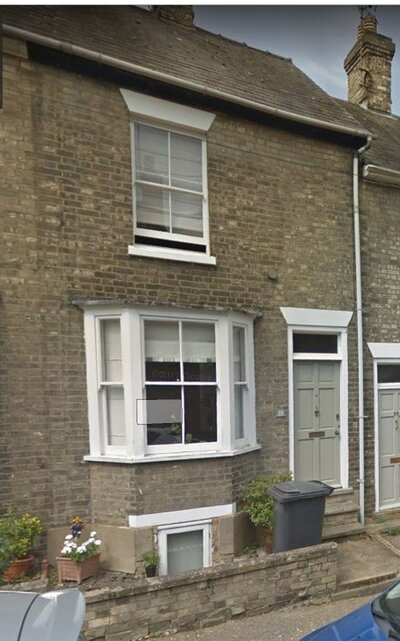
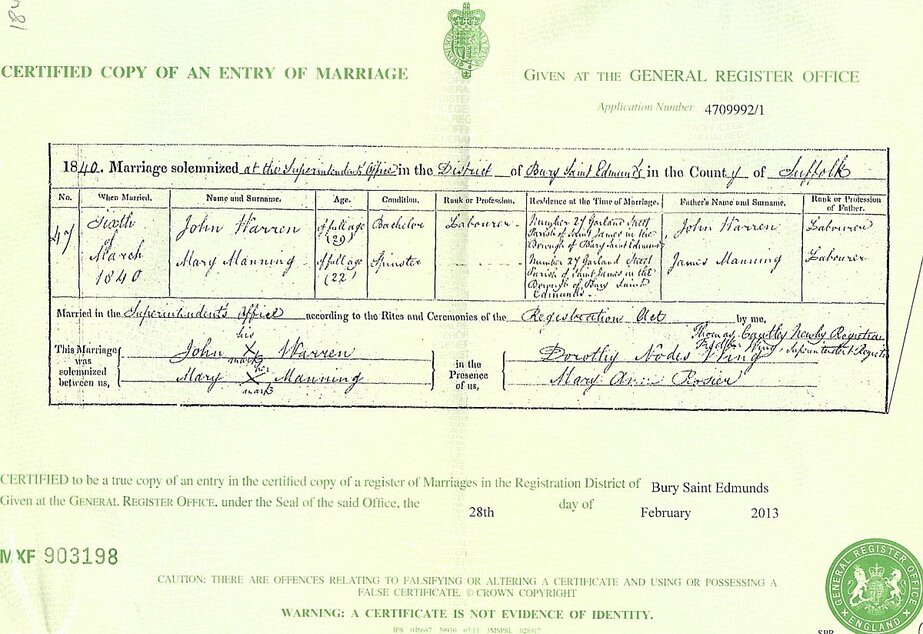
At his marriage to Mary, John gave his father’s name as John Warren, labourer and Mary’s father was James Manning, also a labourer.
1841 – Census, Langham Suffolk
At the time of their marriage in 1840, there were already two children – Elizabeth, aged 6 years and George, aged 4 years, which I have presumed were from John's earlier marriage to Elizabeth Manning. The 1841 census in Langham, Suffolk showed -
• John Warren, Male, 29 years, Agricultural Labourer, Birthplace, Langham, Suffolk• Mary Warren, Female, 22 years, no occupation, Birthplace, Langham, Suffolk• Elizabeth Warren, Female, 6 years, Birthplace, Langham, Suffolk• George Warren, Male, 4 years, Birthplace, Langham, Suffolk
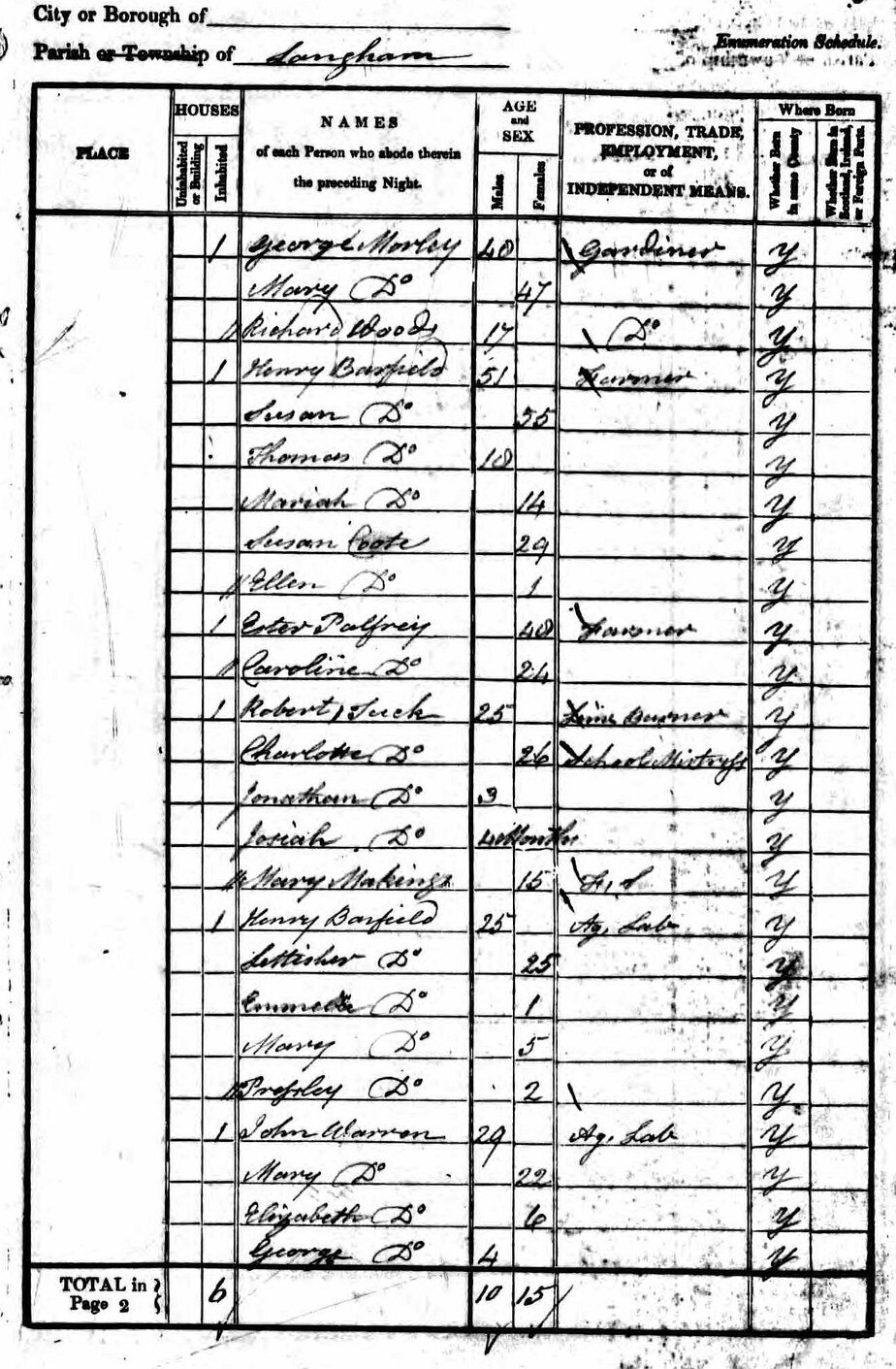
The community was obviously a close one with many family members remaining close to their birthplace, and therefore close to their parents and siblings because on another page of the census were listed the family of James and Elizabeth Manning who were Mary’s parents.
Their details from the 1841 Census were –
• James Manning, Male, 48 years, Agricultural Labourer, Birthplace, Langham, Suffolk• Elizabeth Manning, Female, 47 years, Birthplace, Langham, Suffolk• Samuel Manning, Male, 18 years, Birthplace, Langham, Suffolk• Charles Manning, Male, 6 years, Birthplace, Langham, Suffolk• Frances (Fanny) Manning, Female, 15 years, Birthplace, Langham, Suffolk• Charlotte Manning, Female, 14 years, Birthplace, Langham, Suffolk• Ann Manning, Female, 9 years, Birthplace, Langham, Suffolk
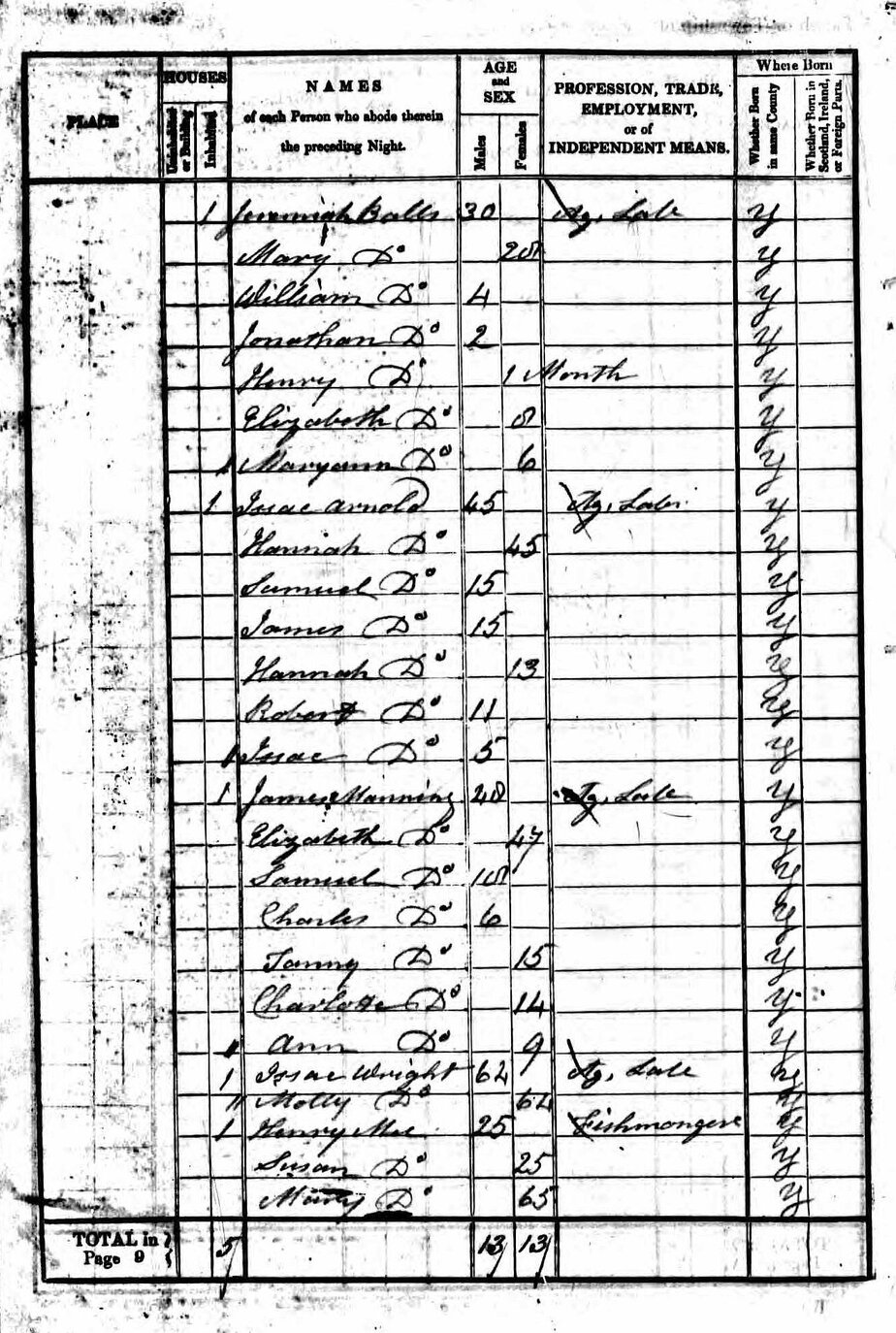
1843 to 1850 – More Children Born
In the following years two more daughters were born to John and Mary Warren – Charlotte born in 1842 and Emma born in 1844, both at Langham, Suffolk.
First name(s) CHARLOTTELast name WARRENBirth year 1842Birth quarter 2Registration month -Mother's maiden name -District StowCounty SuffolkCountry EnglandVolume XIIPage 440Category Birth, Marriage, Death & Parish RecordsSubcategory Civil BirthsCollections from Great Britain, EnglandSource: England & Wales Births 1837-2006 www.findmypast.co.uk
First name(s) EMMALast name WARRENBirth year 1844Birth quarter 2Registration month -Mother's maiden name ManningDistrict StowCounty SuffolkCountry EnglandVolume 12Page 461Category Birth, Marriage, Death & Parish RecordsSubcategory Civil BirthsCollections from Great Britain, EnglandSource: England & Wales Births 1837-2006 www.findmypast.co.uk
These daughters were followed by two sons – on October 24, 1846, Oliver at Walsham le Willows, Suffolk and in 1850, Montefiore.
First name(s) OLIVERLast name WARRENBirth year 1846Birth quarter 4Registration month -Mother's maiden name ManningDistrict StowCounty SuffolkCountry EnglandVolume 12Page 435Category Birth, Marriage, Death & Parish RecordsSubcategory Civil BirthsCollections from Great Britain, EnglandSource: England & Wales Births 1837-2006 www.findmypast.co.ukFirst name(s) MONTAFERELast name WARRENBirth year 1850Birth quarter 2Registration month -Mother's maiden name ManningDistrict StowCounty SuffolkCountry EnglandVolume 12Page 499Category Birth, Marriage, Death & Parish RecordsSubcategory Civil BirthsCollections from Great Britain, EnglandSource: England & Wales Births 1837-2006 www.find,mypast.co.uk
1848 – Marriage - Frances Manning to William Major
During this time, in 1848, Mary Manning’s younger sister married William Major, registered in Stow, Suffolk.
First name(s) FRANCESLast name MANNINGMarriage quarter 3Marriage year 1848Spouse William MajorDistrict StowCounty SuffolkVolume 12Page number 637Source: England & Wales Marriages 1837-2005 www.findmypast.co.uk
1851 – Census - John Warren and family
By the Census of April in 1851, John aged 42 years, his wife Mary, aged 32 years and their children were living in Langham, Suffolk. Also boarding with the Warrens were Mary’s younger sister, Frances who had married William Major in 1848.
The transcription of the census document reads –
• John Warren, Head, Male, 42 years, Agricultural Labour, Birthplace, Langham, Suffolk• Mary Warren, Wife, Female, 32 years, Birthplace, Langham, Suffolk• Elizabeth Warren, Daughter, Female, 16 years, Birthplace, Langham, Suffolk• Charlotte Warren, Daughter, Female, 8 years, Birthplace, Langham, Suffolk• Emma Warren, Daughter, Female, 6 years, Birthplace, Langham, Suffolk• Oliver Warren, Son, Male, 4 years, Birthplace, Langham, Suffolk• Montefiore Warren, Son, Male 10 months, Birthplace, Langham, Suffolk• William Major, Lodger, Male, 29 years, Agricultural Labourer, Birthplace, Langham, Suffolk• Frances Major, Lodger’s Wife, Female, 25 years, Birthplace, Langham, Suffolk
As an agricultural labourer supporting so many young children, money would have been tight indeed and no doubt the additional board payment from the lodgers came in handy.
But where was John Warren’s son, George on the night of the census?
A search of the census records for Langham found that Mary’s father and his family lived just eight houses away from John Warren. And it was here I found John Warren’s son, George – Was he just visiting on the night of the census? Or did he prefer to live with his maternal grandparents because he had a problem with his father being married to his Aunt Mary?
• James Manning, Head, Male, 62 years, Agricultural Labour, Birthplace, Langham, Suffolk• Elizabeth Manning, Wife, Female, 60 years, Birthplace, Langham, Suffolk• Charles Manning, Son, Male, 17 years, Agricultural Labourer, Birthplace, Langham, Suffolk• Samuel Manning, Lodger, Male, 28 years, Agricultural Labourer, Birthplace, Langham, Suffolk• Sarah Manning, Lodger’s wife, Female, 28 years, Birthplace, Langham, Suffolk• Elizabeth Manning, Lodger’s child, Female, 7 years, Scholar, Birthplace, Langham, Suffolk• George Warren, Lodger, Male, 16 years, Agricultural Labourer, Birthplace, Langham, Suffolk
Also boarding with the Manning family were James Manning’s married son, Samuel Manning and his wife and daughter.
1850 - England
England from the 1770’s through to the 1820’s experienced what has become known as the Industrial Revolution. The period of machination had arrived in manufacturing as well as in farming, which meant that the largely agrarian economy (farming) was transformed into the world’s first industrial economy.
The resulting displacement of large numbers of families who had for generations been engaged in agriculture – straw plaiting, farm labouring, etc. – found it difficult to find work. These people were primarily unskilled and unsuited to take their place in the changing mechanised world. The impact of the transition brought about by the Industrial Revolution was wide-spread and permanent. The English economy, previously reliant on manual labour and draft-animals, became an economy based on machine-based manufacturing and agriculture.
In some parts of the south and east of England, women and children were employed in wood spinning, lace making, straw plaiting and other cottage industries. Employment opportunities in these cottage industries declined in the early nineteenth century. This decline of cottage industry reduced the ability of women and children to contribute to household income. This decline together with the decrease in agricultural labourers’ wages caused many rural household’s incomes in southern England to fall dangerously close to subsistence.
Amendments to the Poor Laws also contributed to agricultural labourers revolting in the early 1830’s. These revolts were called the Swing Riots. These were widespread uprisings by agricultural workers beginning with the destruction of threshing machines and tithe barns. Protesters wanted a fairer system of wages and tithes. (Tithes were one tenth of farms’ produce which had to be given to the church and was stored in tithe barns.)
The anger of the rioters was directed at the tithe system, the Poor Law and rich tenant farmers who had been reducing wages for labourers with the introduction of the new machinery. Those rioters who were caught faced charges for arson, robbery, riot, machine breaking and assault and if convicted faced imprisonment, transportation and ultimately execution. In Parliament Lord Carnarvon said that the English labourer was reduced to a plight more abject than that of any race in Europe with their employers no longer able to feed and employ them.
John Warren clearly had no other means of providing for his family than as an agricultural labourer. And the family income which Mary and the children supplemented in their cottage industry activities would have also been in sharp decline.
It was at this point that John aged 42 years old and Mary made the decision to leave their homeland and all they had ever known to make the perilous journey to the other side of the world to the new land of Australia.
Of course, it meant leaving behind their extended family and taking the huge gamble that life would be better in the new land. The dream of owning his own land and house and being free from the yoke of peasantry that so inhibited him in England stirred his resolution.
So it was that John Warren left his home in Suffolk, England in 1851 accompanied by his wife, Mary and their young family to settle in the virtually unknown land on the other side of the world.
John was to become one of the early pioneers of South Australia.
He struggled to establish himself in a proper house after living with his growing family in “a hut” for several years, eventually saving enough money to purchase his long-dreamed-for plot of land in Happy Valley in South Australia.
He died there some 16 years later, but not before he had established the Warren family in Australia.
Let’s not get ahead of ourselves - let us look at the next phase in the life of John and Mary Warren.
1851 – Assisted Migrants’ Scheme
John Warren and his family came to Australia under The Assisted Migrants Scheme. In order to be eligible for help under this scheme, candidates were required to be …. sober, industrious, of good moral character, in good health, free from all mental and bodily defects, and have been vaccinated against or have had smallpox.
Further, passage was not granted -
• To persons Intending to resort to the goldfields in the other Australian Colonies• To persons in the habitual receipt of parish relief• To parents without all their children under sixteen, then in Britain• To children under sixteen without their parents• To husbands without their wives, or wives without their husbands (unless in the last three instances the parents, husband, or wives, be already in the Colony)• To single women who have had illegitimate children• To persons who have not arranged with their creditors
Having qualified as eligible the next step was to apply to Her Majesty’s Land and Immigration Commissioners in London with their marriage certificate. Then followed a personal inspection of the applicants after which they would be told whether a passage was to be granted or not.
If passage was granted, an embarkation order from Her Majesty’s Land and Immigration Commissioner was issued naming the ship in which they were to sail and the time and place of joining her.
Next came payment. No doubt struggling to scrape up enough money to pay for the voyage, John declared his family and paid a total of £33. The family then received instructions about how to outfit themselves. The smallest quantity that was permitted for each male over 12 years old was –
• 6 shirts• 6 pairs of stockings• 2 warm flannel shirts• 2 pairs of new shoes or boots• 2 complete suits of strong exterior clothing• 4 towels• 2 pounds of marine soap.
And for each female over 12 years of age -
• 6 shifts• 2 flannel petticoats• 6 pairs of stockings• 2 pairs strong boots or shoes• 2 strong gowns (one of which made of warm material)• 4 towels• 2 pounds of marine soap
It was also recommended that two or three coloured shirts for men and an extra supply of flannel for women and children was very desirable.
For each person over 12 years of age, the quantity of baggage must not exceed 20 cubic feet, nor half a ton in weight. Extra baggage had to be paid for. Remember, John and Mary were moving their family, household and occupation permanently - so household goods, clothes, tools and work implements, cooking utensils and all the other paraphernalia needed to establish themselves in some sort of accommodation and income producing work was needed.
Mattresses, feather beds, firearms, offensive weapons, winces, spirits, beer, gunpowder, percussion caps and matches were banned.
The payments made by the passengers went towards the supply of bedding and eating utensils used during the voyage.
The Sailing Ship – Reliance
The Reliance was a 3-masted sailing ship of 805 tons built in 1845 at St. John, New Brunswick. No photo of the Reliance is available.
Goodbyes said, belongings packed, children gathered, it was time for the journey from Langham to Plymouth to join their ship. The illustration below shows families in a laden wagon heading to their new life – probably exactly the way John and Mary travelled.
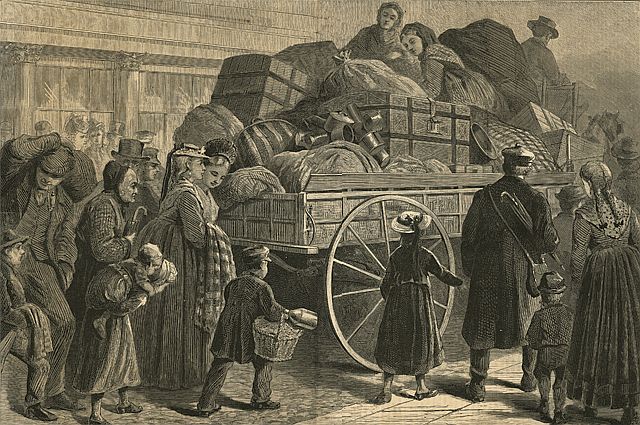
Once at Plymouth, they would look upon their ship waiting at the dockside. The ship Reliance was captained by H.B. Fell. John and Mary boarded their ship with their six children, the youngest Montefiore Warren, just 10 months old. Once on board, all passengers were asked to produce their documents including receipt for monies paid, before being allowed to proceed below decks to stow their belongings and secure their sleeping arrangements.
George listed his family for passage on the Reliance thus –
• John Warren, 42 years of age• Mary Warren, 32 years of age• Child Elizabeth, 14 years of age• Child George, 14 years of age• Child Charlotte, 8 years of age• Child Emma, 6 years of age• Child Oliver, 4 years of age• Baby Montefiore, babe-in-arms
It was at this stage that John was found to have under-stated the age of Elizabeth, his oldest child – she was actually 16 years old, and she had also been employed as a servant. And even though Baby Montefiore was a babe-in-arms, John still needed to declare him and pay as an additional child.
Consequently, before the family were permitted to proceed John was required to pay “an extra contribution beyond the two pounds per head on account of age, occupation or excess of young children”. He was charged an additional £14 on top of what he had already paid. Money matters sorted, the family went below and stowed belongs and made ready for the trip of their lifetime.
Also on board the ship was Mary’s younger sister, Charlotte Manning, aged 24, listed as a servant from Suffolk as well as two young men, Samuel and William Gray, who were fleeing England to escape a poaching charge. These two men were the sons of Isaac Gray who will figure later in the life of Mary.
Co-incidentally, one of the crew members was named James Manning but whether he was related to our Mary Warren, nee Manning has not yet been determined.
The sailing ship Reliance set sail from Plymouth on June 10, 1851.
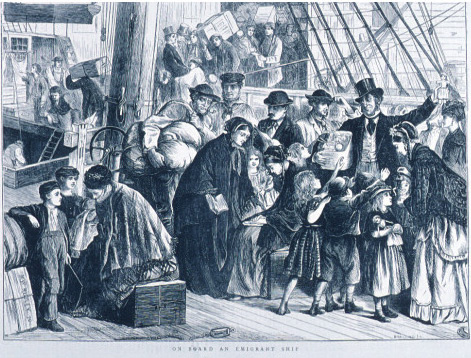
Once at sea, the passengers had to conform to a rigid system of control according to the law of the ship. The roll call at sea was a review of all passengers by the officers to determine their sanitary condition and to see if they have complied with the regulations. The passengers were to pass up the starboard gangway to the upper deck, and then return to the main deck by the port side for inspection.
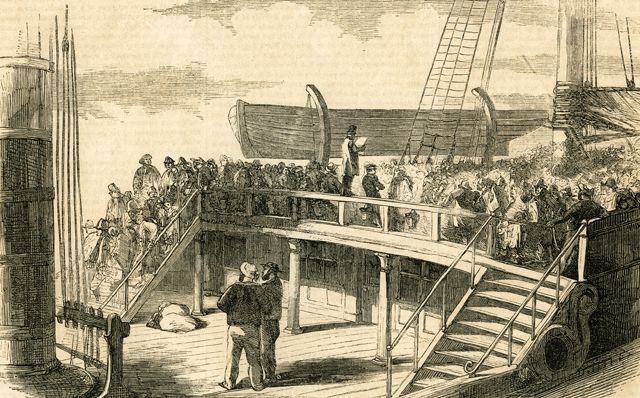
Roll Call on Board the Ship Reliance
The route taken by the captain of the Reliance was - The Great Circle Sailing Route. This meant that the ship took a course to keep it to the east of South America, rather than down the coast of Africa. This way, the ship rounded the bottom of Africa far to the south, thus avoiding the dangerous passage past the Cape of Good Hope at the bottom of Africa. This also allowed the ship to get caught in the Roaring Forties winds that pushed it quickly up to the Australian south coast.
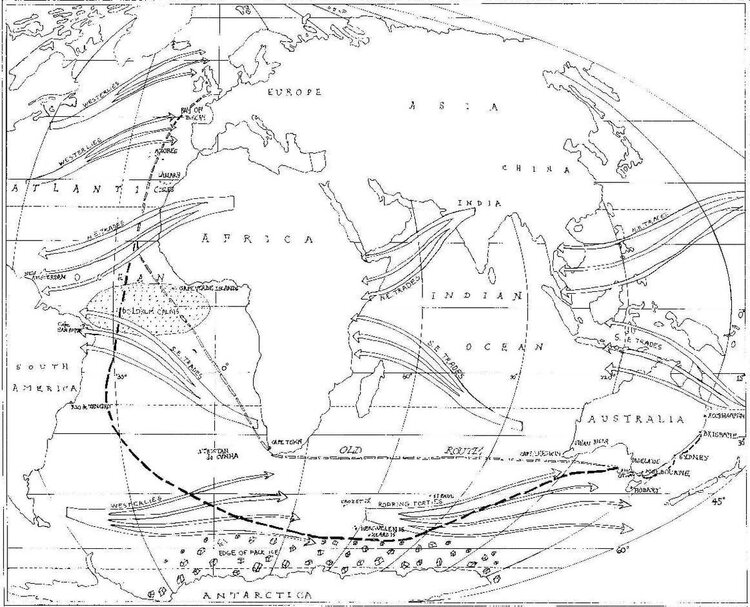
Having departed England on June 10, the captain reported that he found this route quite advantageous. By July 10 they passed the Brazil Coast, near Pernambuco. The ship then passed the meridian of Greenwich on August 9, then doubled the Cape of Good Hope on August 14, making Kangaroo Island on September 11. But owing to a strong north-west wind and a very high sea, he had to stand to the southward all night. The captain reported that the ship never had to close-reef the topsails and the thermometer was never lower than 31 degrees at 9 o’clock in the morning.
By September 13, she got a pilot on board mid-morning and anchored at the North Arm, Adelaide about 5 pm.
This might sound like it was a fantastic adventure and a wonderful voyage for those involved, but the reality was quite different. During the three-month voyage, 19 people died – a disproportionate number compared with the 313 people who eventually disembarked in Adelaide. A newspaper report in the South Australian Register dated Monday, September 15, 1851 called for some special explanation and comment – (Note the error in the number of deaths reported in the article.)
Transcription of Article in “South Australian Register” dated Sep. 15, 1851
The deaths during the Reliance voyage included John and Mary’s son, Montefiore. More than half the deaths were of children under 3 years of age.The very unpleasant smell was a cause of complaint by the passengers and it was noted that similar complaints had been made by passengers on board other vessels arriving with cargos of patent fuel. The newspaper report called on the Government to enquire into this serious matter and to ensure those in England did not charter such vessels in future. The report also noted that passengers were embarked both from Plymouth and Liverpool – a very objectionable arrangement involving tedious delay for emigrants first embarked.
Name Age (yrs) Date of Death Cause of Death Where BuriedSmith, Thomas 3 Sept 15 Convulsions On shoreWalter, Elizabeth 10 mths Sept 16 Fever & convulsions On shoreRose, Emma 2 ½ Sept 18 Fever On shoreBell, Mary A 24 July 17 Disease of the heart At seaHunt, George 22 July 23 Committed suicide At seaJackson, James 26 July 27 Diarrhoea At seaWatson, Janet 23 Aug 1 Fever At seaClyne, Elizabeth 23 Aug 1 Fever At seaMott, Rosena 3 Aug 7 Mesenteric disease At seaThrower, Edmund 35 Aug 15 Diarrhoea At seaClyne, James 21 Aug 20 Consumption At seaCropman, Robert 10 mths Aug 31 Inflammation of the lungs At seaReynolds, Elizabeth 2 mths Aug 31 Inflammation of the lungs At seaWarren, Montefiore 18 mths Aug 31 Inflammation of the lungs At seaLock, William 3 Sept 1 Inflammation of the lungs At seaReynolds, Martha 18 mths Sept 3 Diarrhoea At seaSmyth, Mary 30 Sept 7 Consumption At seaPeople, Edwin 26 Sept 10 Diarrhoea At seaChapman, Thomas 8 mths Sept 11 Inflammation of the lungs At sea
It is interesting to note that the ship Reliance had still not set sail from Adelaide at the end of November that year. The Captain, Ctn. Fell, wrote to “The Times” newspaper on November 28, 1851 to answer complaints about the delay of the Overland Mail by the non-sailing of his ship. Captain Fell wrote –
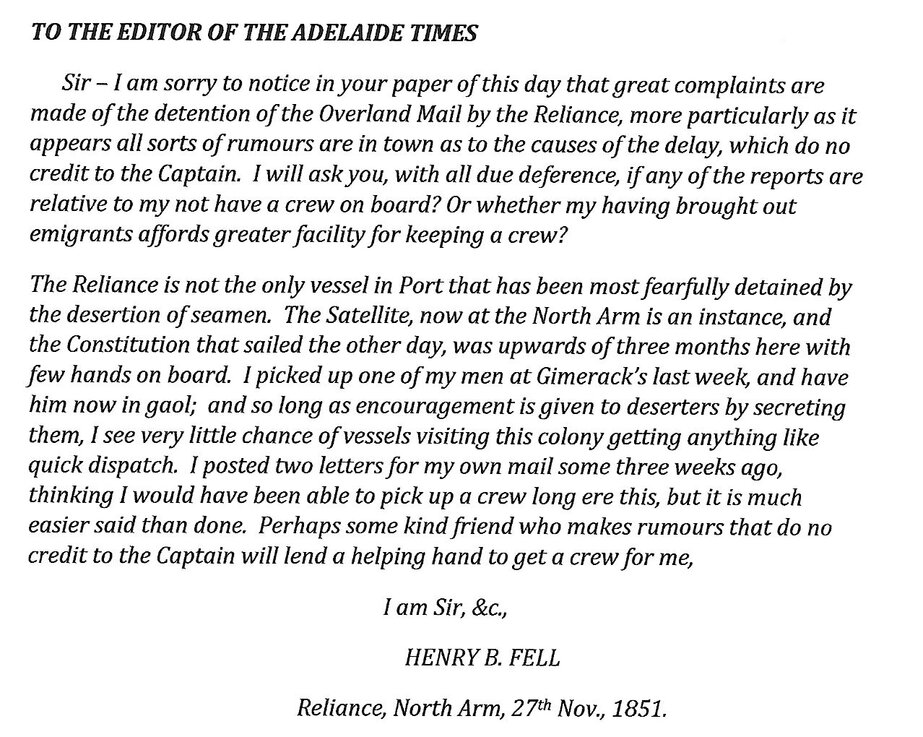
The chance of a new life in the growing colony as well as the booming gold rush in Victoria and Western Australia were no doubt inducements to deserting crew.
1851 - Adelaide, South Australia
What was the Adelaide of 1851 like into which the Warren family stepped?
The settlement had been founded in 1836, some 15 years prior to John and Mary’s arrival. During that time, industrious pioneers had taken the settlement from virgin bush and tents to a brave and growing town.
The first newspaper, the Register, was established and its first edition printed in 1838. Hotels were established and the Theatre Royal, Adelaide’s first, opened in rooms above the Adelaide Tavern in May,1838. The settlers, encouraged by England and the local authorities took an active and sympathetic attitude towards the local aboriginal tribes, although there was understandably some antipathy created by the settlers taking over some of the tribes’ favourite areas.
South Australia’s first depression occurred in the early 1840’s when the population dropped from 8,480 in 1840 to just 6,107 in 1844.
In the early 1840’s the young colony was almost bankrupt, but fortunately the discovery of copper at Burra helped keep South Australia afloat.
Settlers seemed well pleased with their new situation in South Australia. A letter sent to England by Sarah Gray, the first wife of Isaac Gray (of whom you will read more a little later in Mary Manning’s story as he became Mary’s fourth husband) describes the living conditions in Happy Valley at that time. She wrote –
“ I have a very nice house. Hiring rates are about 5 shillings per day, or 12 shillings a week plus board. This is a very fine country – it truly flows with milk and honey. We have beautiful churches and schools. The prices of food-stuffs – Bread is 7 pence per loaf, Sugar is 3 pence, Tea 2 shillings, 1 pound of beef 3 pence, Best butter 1 shilling (as good as any made in EnglandMilk 5 pence per quart, Good potatoes 1 penny per pound.All kinds of eating, wearing are cheaper than at home. The people are more hospitable than at home. “
1849 - Gold in California
Then in 1849, gold was discovered in California. The South Australian Immigration Agent reported that 588 men had sailed from Adelaide bound for California in the first three months of 1850 and several vessels planned to sail. Men walked off farms and there were too few to harvest the crops. Shepherds abandoned their flocks. Crews deserted the ships in harbour. Shopkeepers and merchants closed their doors. Government employees were dismissed. The police force was reduced. Newspapers closed. The Kapunda and Burra copper mines were forced to reduce the number of their workers. Kapunda kept only four men maintaining the pumps to prevent the mine from flooding. The Burra mine workforce fell from 1,000 to 100.
As if this was not enough to bring the young settlement to its knees, in mid-1851 news arrived of gold discoveries in Victoria and New South Wales. The newspaper, the Register, predicted mass movement of the working men from farms to the goldfields seeking their fortune as well as increased prices that would follow this labour shortage. And these predictions were correct – hundreds of men left SA bound for the goldfields of Bendigo and Ballarat.
And the hundreds of men who went to the goldfields, withdrew their savings from the banks to fund their gold ventures, which left the banks without sufficient coinage. SA was in financial trouble.
Nevertheless, the enterprising SA merchants and farmers benefited by sending their goods, such as food and prefabricated wooden huts, to the Victorian gold fields.
The Register newspaper reported under the heading of “Overland Traffic” –
“ Among the spirited traders is a Mr. Dodd of Clarendon who has dispatched six drays laden with flour, bacon, hams, etc.In July 1852 a report from Mount Alexander stated that flour was selling at between £18 and £20 per bag, hams 4 shillings, sugar (very dark) 1/3d. (one shilling and three pence) to 1/6d. The report went on to list bacon, cheese, potatoes, rice, oats and candles. Small skinny sheep are sold in quarters at the rate of 16/-d. each. Fortunately, tea, the only beverage obtainable here, except muddy water, is very reasonable at between 3/-d. to 3/6d. per pound. Salt is as dear and at some places more costly, than sugar. “
Some goods were shipped by steamer up the Murray River. For five years SA was an important supplier to the Victorian market.
In 1850 planning began for a railway between Port Elliot and Goolwa. It was officially opened in 1854 when the first public library in SA was also opened.
Adelaide’s city population in 1844 was just over 6,000 but six years later in 1850 had grown to 11,000.
We can get some idea of what greeted the Warren family on their arrival from a letter written by the Bishop of Adelaide on July 30, 1849 –
“ Once arrived, an emigration agent boarded the shop and examined the condition and discipline of the passengers and to offer counsel where needed.Persons who were deemed to be destitute by the agent had their transport into Adelaide – 8 miles – paid plus the transport of their luggage.Cottages built by the government at Port Adelaide are available for temporary accommodation to passengers who fail to secure situations before they are compelled to leave the ship. Usually, it takes 14 days for the re provisioning of the ship after reaching port before departure.A Colonial Labour Office was established in Adelaide for the hiring of servants and labourers.A “Stranger Friend Society” is available to relieve distress in cases of sickness among the new arrivals and a government fund is available for destitute persons.Wages are high and no fear of starvation. Meat is 2 ½ pence per pound, sugar 3 pence, tea 2 shillings and bread 1 ½ pence.
1851 - Settlers at Happy Valley, South Australia
The Adelaide into which John and Mary stepped in September 1851 was a raw, young colony and it may be supposed that after such a harrowing voyage they would have been relieved to step onto solid ground.
Perhaps John and his family bunkered down in the government supplied cottages for a short time. Or they may have remained on board the ship for a couple of weeks. But soon enough, the young family selected the tranquil countryside of Happy Valley, just south of Adelaide as the place to establish their new life.
My guess is that John soon found work as an agricultural labourer on one of the developing farms at Happy Valley. Crops at that time were mostly food crops of wheat and corn.
John, his wife and six children are listed in the 1836-1885 South Australian Biographical Index as some of the earliest pioneers to the state.
Also living in Happy Valley was a family by the name of Appleton. This family was to become close to the Warren family in many ways over the following years.
John Warren leased a plot of land in Happy Valley and eventually built a hut for the family, perhaps with the help of his eldest son, George Warren who was 18 years old – or had George already flown the coop to establish his own life? Oliver was the next oldest son at 9 years old.
Settlement was a dirty and haphazard process! By 1850, the River Torrens, once a sylvan stream was a succession of ugly, muddy ponds, its banks denuded of the gums and undergrowth that once had made them a beauty spot. Under the strain of up to 500 cart loads of water a day for the burgeoning city of 11,000 inhabitants, the pools shrank alarmingly at the end of the rain-less summers.
Since the “muddifying” of the water, most of the water carriers placed large cautionary placards on their carts – BEWARE OF DYSENTRY AND FEVER!! Water carriers delivered water to outlying settlements like Happy Valley and the house-owners were requested to provide two containers with “bungs” and leave them in a shady place for re-filling by the carrier. The cost for water delivered this way in 1850 was between 1/6d. (one shilling and 6 pence) and three shillings, depending on the distance travelled.
1851 – Marriage - Charlotte Manning to Daniel Free
Remember Mary Manning’s younger sister, Charlotte, who also made the trip to Adelaide on board the Reliance. Charlotte wasted no time in finding a husband – she married on November 25, 1851 in Adelaide to Daniel Free.
Name: Charlotte ManningSpouse Name: Daniel FreeMarriage Date: 25 Nov 1851Marriage Place: AdelaideRegistration Place: Adelaide, South AustraliaPage Number: 201Volume Number: 9Source: Australia, Marriage Index, 1788-1950 www.ancestry.com
1854 – Marriage - Elizabeth Warren to Richard Appleton
In 1854 on March 24, John and Mary’s eldest daughter, Elizabeth Warren married Richard Appleton at the Trinity Church in Adelaide. Richard Appleton had arrived into Adelaide on board the ship Stag in 1850 from London.
Name: Elizabeth WarrenSpouse Name: Richard AppletonMarriage Date: 24 Mar 1854Marriage Place: AdelaideRegistration Place: Adelaide, South AustraliaPage Number: 588Volume Number: 21Source: Australia, Marriage Index, 1788-1950 www.ancestry.com
1855 – Birth - Charles James Warren
On March 20, 1855 came the birth of another son for John and Mary. Charles James Warren was born in Happy Valley. He is my Great-Grand-Father.
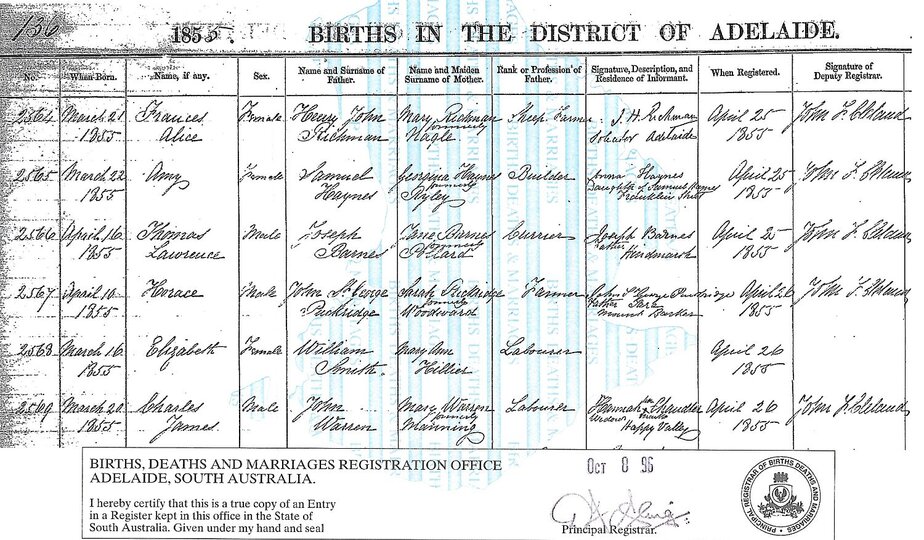
At the time of the birth of this their seventh child, the Warren family were living in “a hut on 6 acres of land.” According to the Rate Assessment Book, the value of their property was just £6.
The basic slab hut derived its plan from the English crofter’s hut, a simple rectangular walled shelter with one door, and perhaps holes to allow air to enter. The interior spaces might later be partitioned off. To this design Australian settlers often added a veranda.
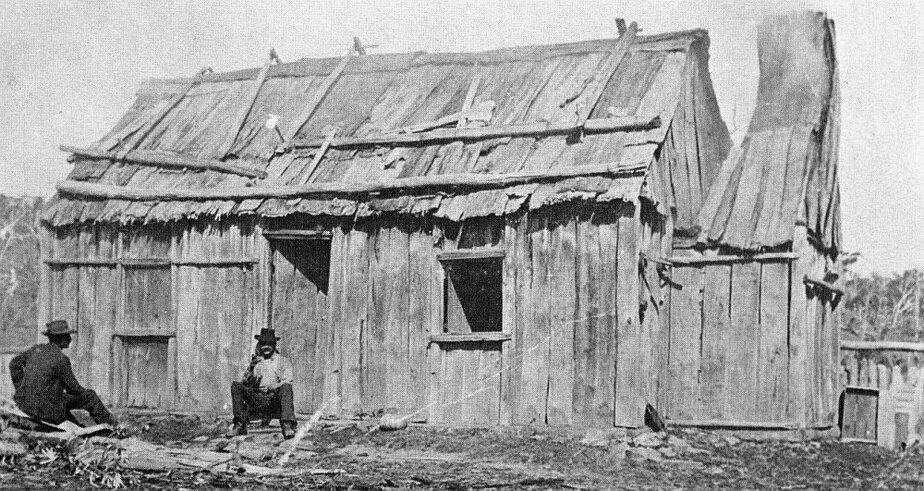
Most slab-hut construction techniques could be described as bush carpentry. Few early settlers could afford the time, or possessed the capital, to build any dwelling more impressive than a slab hut - they had first to clear their land and get a crop planted or pasture fenced.
Since most early settlers had formerly been manual labourers, they brought with them a sound practical ability and aptitude for 'making do'. Other settlers observed or helped those more skilled and copied their techniques. The average settler could thus erect a basic hut in two or three weeks, adding to or modifying it later
Imagine what life must have been like for Mary with young children and a new baby living in a hut with dirt floors, no running water, no sewerage, wood stove cooking if they were lucky or an open fire if not. And oil lights or candles! To obtain usable water, they would have had to dig a well or buy their water.
1856 – Birth - Sarah Jane Warren
A year later in 1856, the family were still living in their “hut on 6 acres of land” – still valued at £6 where another daughter was born on September 29, 1856. She was named Sarah Jane Warren and she would be John and Mary’s last child.
Name: Sarah Jane WarrenBirth Date: 29 Sep 1856Birth Place: Happy ValleyRegistration Place: Adelaide, South Australia, AustraliaFather: John WarrenMother: Mary ManningPage Number: 433Volume Number: 7Source : Ancestry.com. Australia, Birth Index, 1788-1922
1860 – Purchase of Land
By March 20, 1860, John had managed to scrape together enough money to purchase the 6 acres of land in Happy Valley, being part of an 80 acres section of land, from Thomas and William Hales for £60.
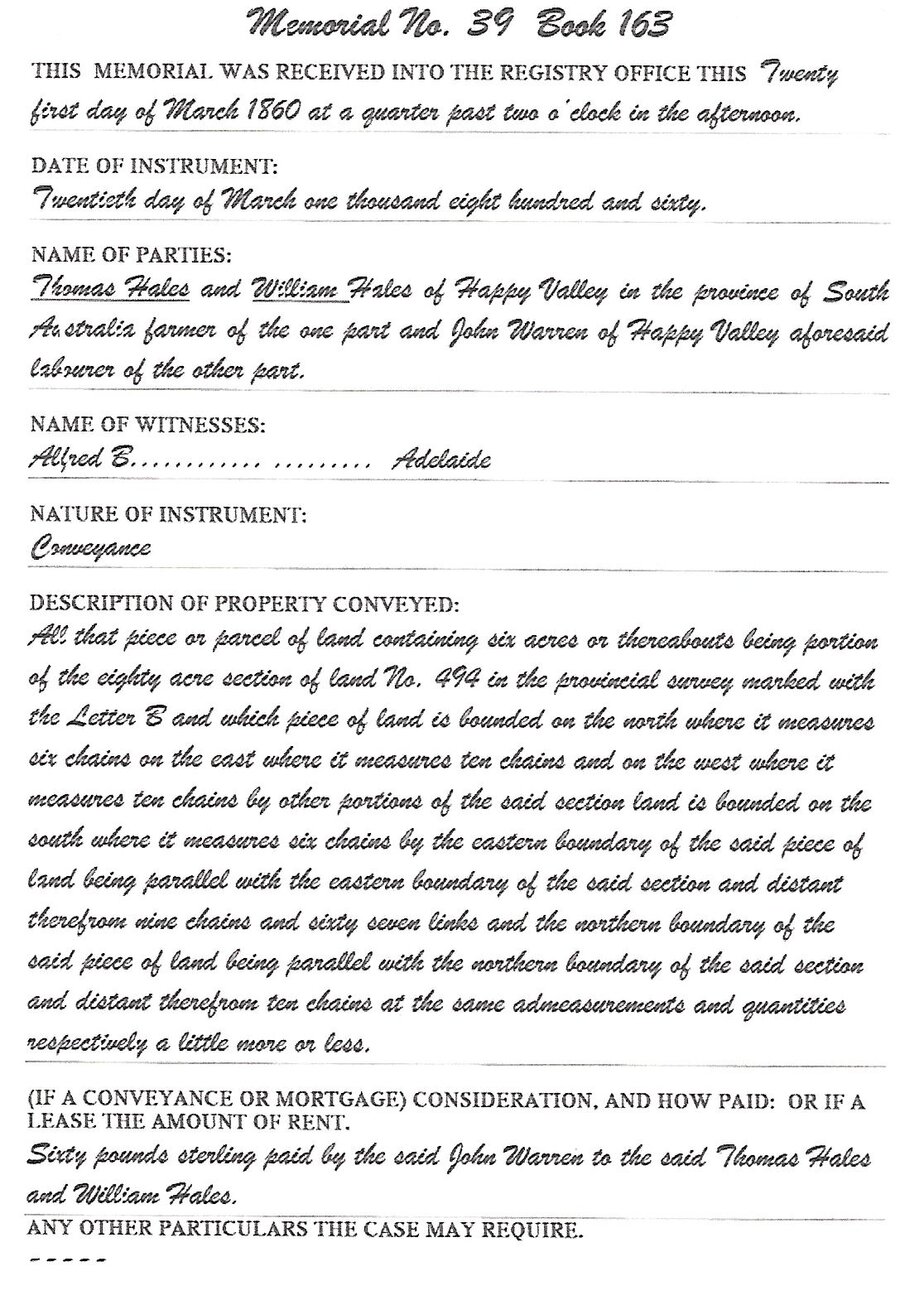
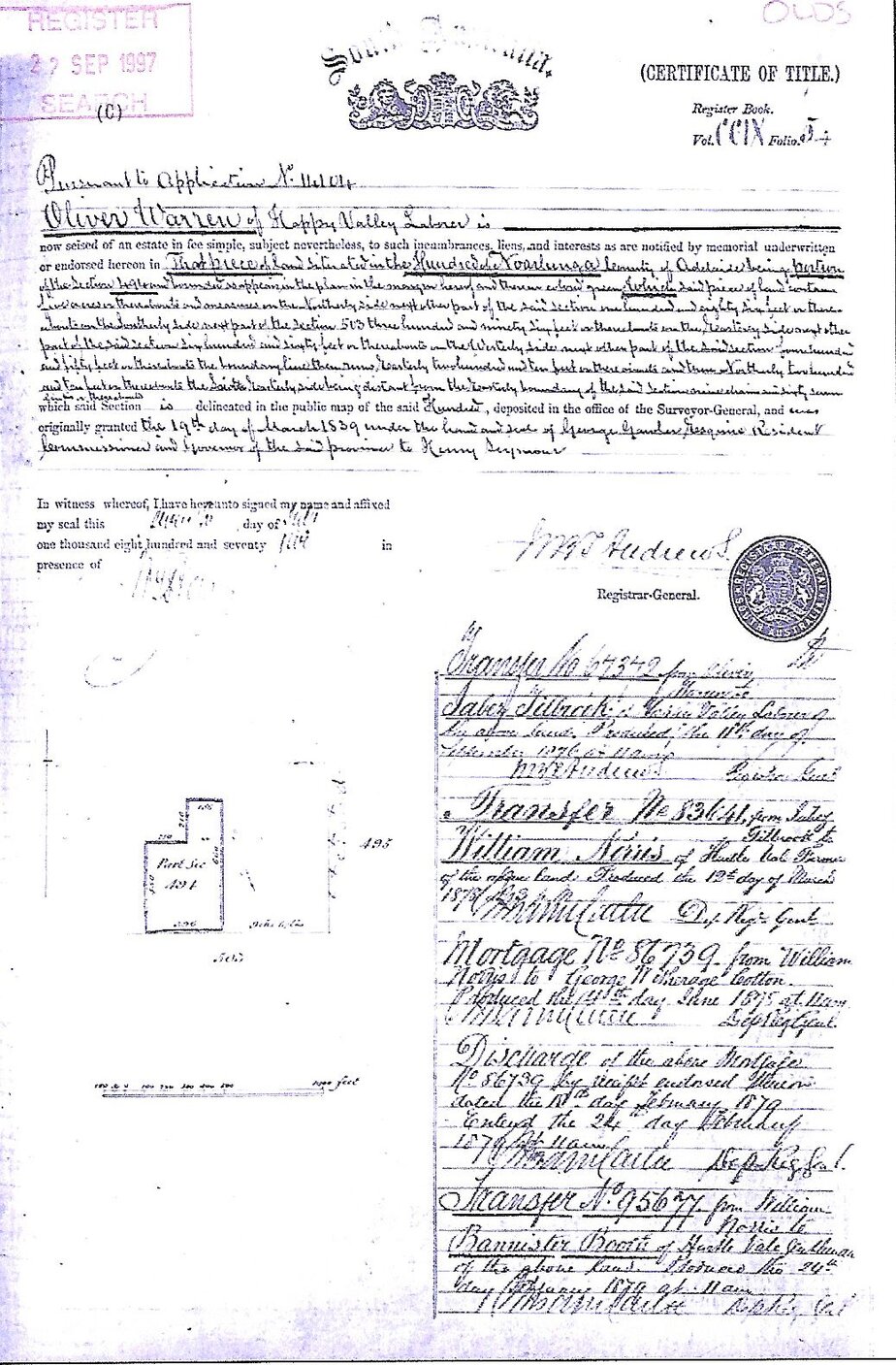
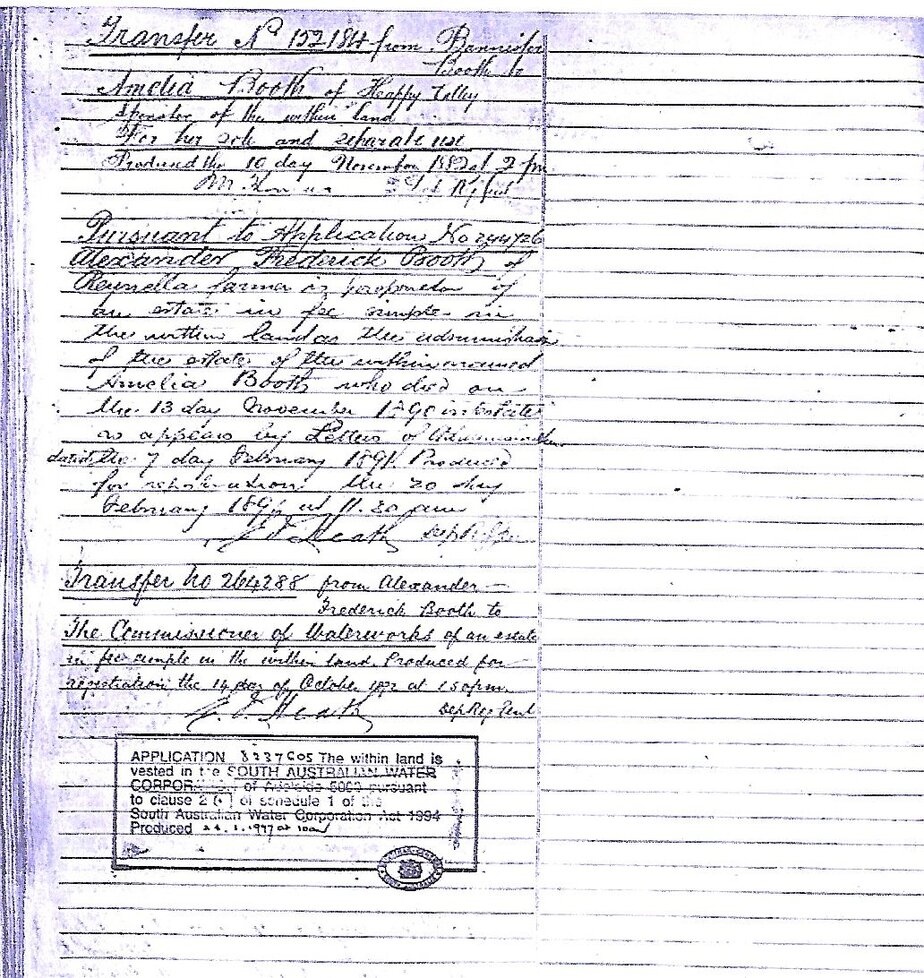
In the same year, the Rate Assessment Book showed John Warren as the owner of the hut and land, valued at £8, on which rates of 10 shillings were to be paid.
John farmed his land – he was listed as a farmer in the South Australian Directory of 1864-1865.
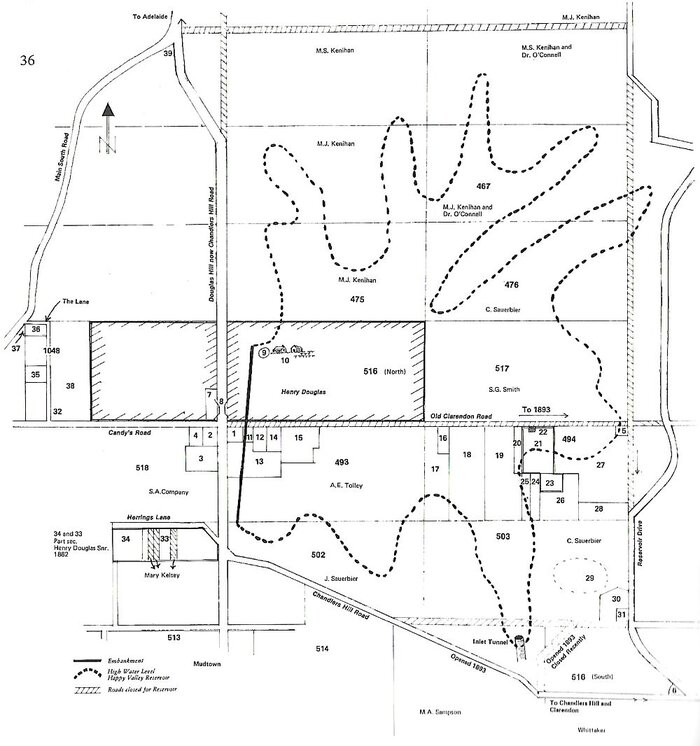
1860 – Economic Slow Down
By the 1860’s the economic success associated with the gold rushes in neighbouring states had given way to a period of economic hardship. The state’s population growth slowed and its agricultural productivity, hit by drought, was greatly reduced.
The impact of this was that a few months after purchasing his land, John pledged his 6 acres of land in Happy Valley as security for a Bill of Exchange dated December 24, 1860 for the sum of £30.
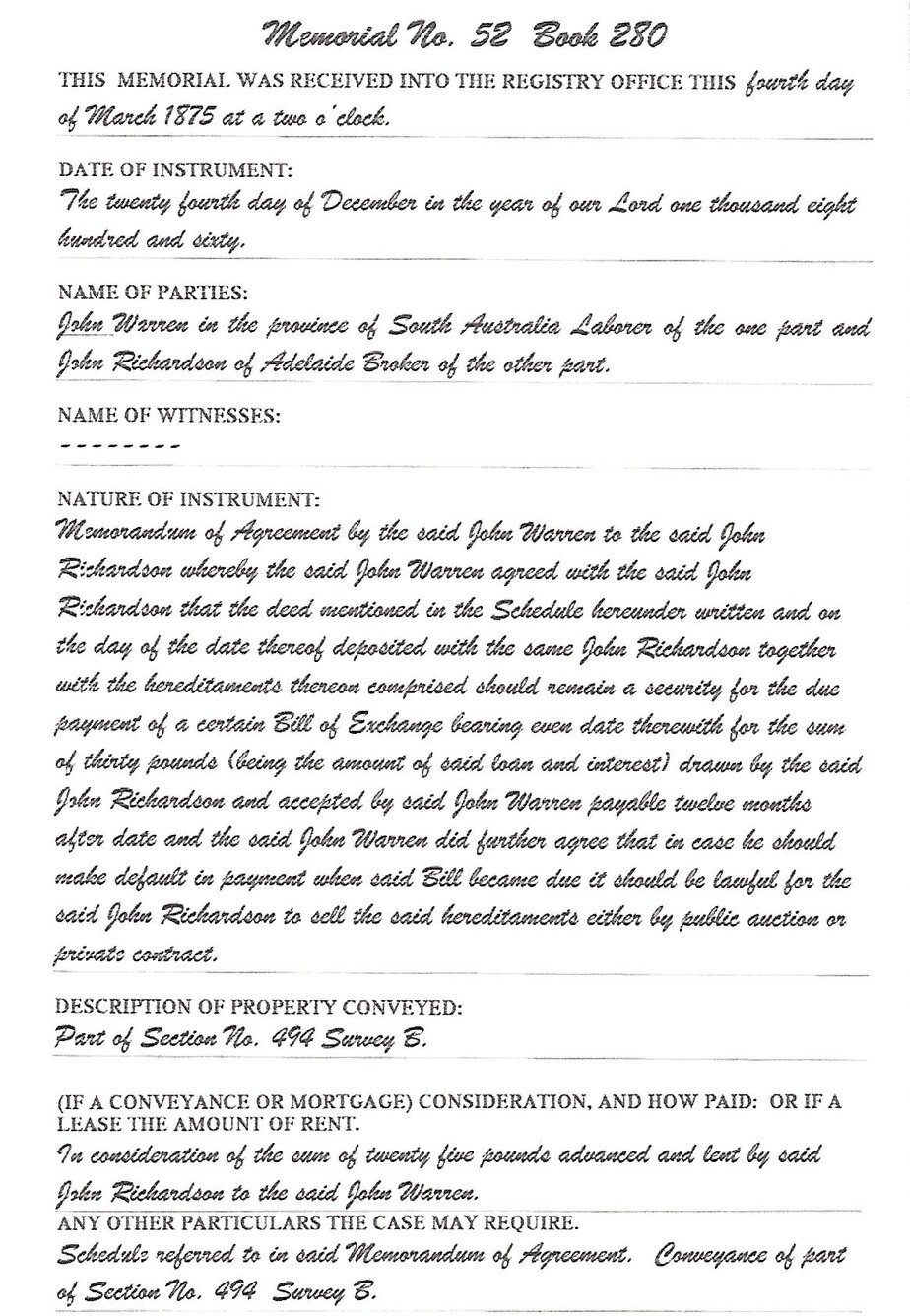
The loan was for £25 with £5 being interest on the loan, repayable in 12 months – a 20% interest rate! A condition of the loan was that if John defaulted when the Bill became due, then John Richardson could sell the land by public auction or private contract to recover the debt.
1861 – Marriage - Charlotte Warren to Francis Appleton
On January 31, 1861, another of John and Mary’s daughters, Charlotte, aged 18 years married Francis Appleton, the brother of Richard, married to Charlotte’s sister, Elizabeth Warren.
Name: Charlotte WarrenFather's name: John WarrenSpouse Name: Francis AppletonSpouse's Father's Name: Richard AppletonMarriage Date: 31 Jan 1861Marriage Place: Morphett ValeRegistration Place: Morphett Vale, South AustraliaPage Number: 358Volume Number: 45Source: Australia, Marriage Index, 1788-1950 www.ancestry.com
1862 – Marriage - Emma Warren to William Chase
And in 1862, Emma, then 17 years old, married William Chase, a farmer of Eyre’s Flat, South Australia. The wedding was celebrated in The Dwelling House of John Warren, Happy
Valley. So, we see that John has built a house for his family to replace his hut!
Witnesses to the marriage were Francis Appleton, Emma’s brother-in-law, storekeeper in Happy Valley and her father, John, shown as a farmer. Emma could only mark the register with her cross as she could not write as very few girls received much education.
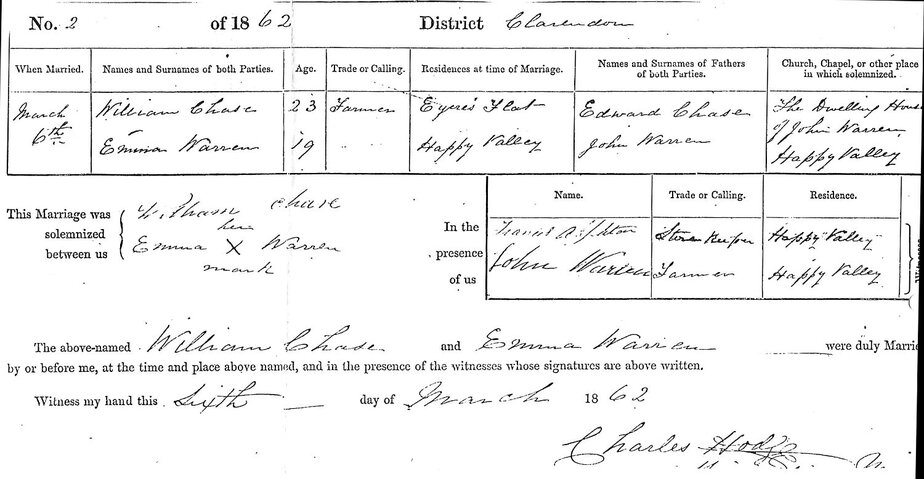
1867 – John Builds a House
John “rolled over” his Bill of Exchange each year. In 1867, the rates book showed the land in John Warren’s name with a house now instead of the original hut with a rateable value £10. Imagine just how hard John and his family must have had to work to become landowners (albeit with a loan attached), progressing from a tent to a hut to a house in their new settlement.
But soon, the golden days for the Warren family would come to an end.
1867 – Death -John Warren
On June 23, 1867, at the age of 59 years, John died as a result of apoplexy induced by vomiting.
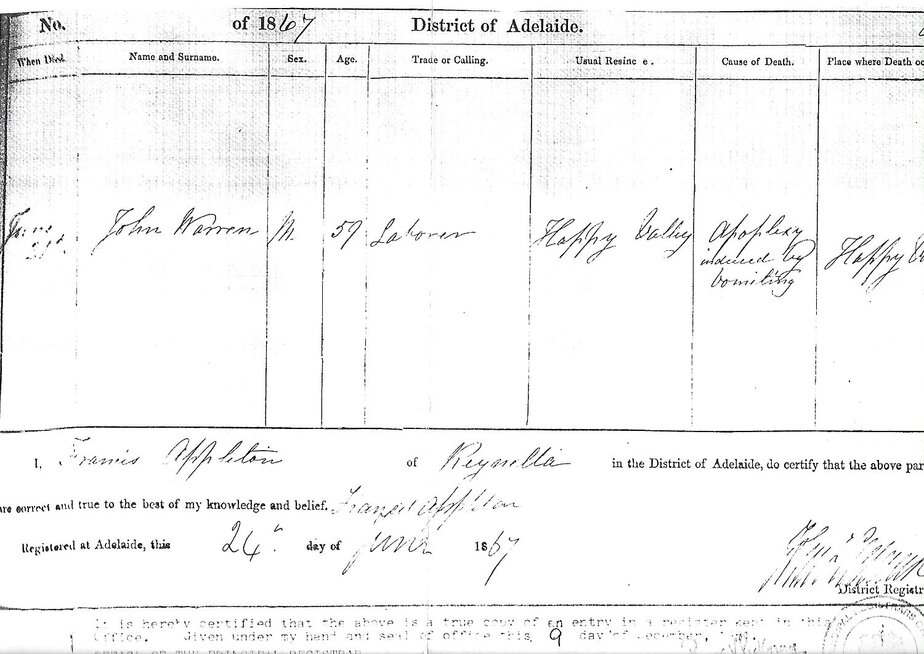
Apoplexy is defined as uncontrolled bleeding from an organ. If left untreated, apoplexy will result in sudden loss of consciousness and paralysis of various parts of the body and ultimately death. In John Warren’s case, the apoplexy induced by vomiting may have been uncontrolled bleeding from the stomach, the gut, the throat or the brain, otherwise known as a stroke.
The person who provided the details for the death register was Francis Appleton of Reynella, John’s son-in-law, and husband to Charlotte Warren.
John was buried in the original Happy Valley Cemetery. His body was later transferred to the Happy Valley New Cemetery when the reservoir flooded the valley. The location of his new grave is West Side (7) 4. The officiating clergy at his original burial was Joshua Foster.
Mary Manning's life after John Warren's Death
1867 – Mary is a Widow
To gain a realistic understanding of the world in which Mary Warren lived and the obstacles she had to overcome as a widow, here is a brief look at some of the historical background in relation to poverty and women’s rights in South Australia at that time –
Poor Relief: The principals behind the 1836 foundation of South Australia was “systematic colonisation” – that is, a careful management of the correct proportions of capital and labour from England in order to create an ideal society that was free from the social, political and economic problems that beset industrial Britain. The idea was that South Australia would be self-sustaining, prosperous, and virtuous. There would be no need for poor relief because poverty would not exist – or so it was planned!
But several factors combined to prevent this plan from success. A government enquiry in 1856 into the increasing amount of destitution in the colony found –
- A bad harvest had reduced employment and increased the cost of living
- The desertion of wives and children by men leaving the colony to seek their fortune in the Victorian goldfields
- The number of mining deaths which left widows and fatherless children
- An excess of female immigrants which reduced the price of labour and increased unemployment
- The incidence of men failing to make their fortune in the goldfields and therefore either unable or unwilling to send money back to their family
- The failure of children to support their parents when needed.
The enquiry also found that the 1843 legislation that required three generations of a family to provide support for deserted wives and children and other destitute persons was not adequate as there were often not the normal family ties in their new society.
The Destitute Board: Consequently in 1849 the government formed “The Destitute Board” to provide support for the needy. At this time, a total of 139 persons received relief, but by 1851 as accommodation at the “Destitute Asylum” was deemed inadequate to cater for the 250 persons receiving help. “The Destitute Board was granted temporary use of the Police Barracks on North Terrace.
The number of destitute in the community who required support continued to spiral – in 1853 there were 464 persons being helped. In the following year there were 685 persons and in 1855, a total of 3,027 needed support. In the six years from 1849 to 1855 the number of people qualifying as destitute had increased by over 2,000%!
The destitute included single women, deserted women, widowed women, children, and men.
Divorce & Separation: The Matrimonial Causes Act of 1858 allowed divorce and separation, but it was weighted heavily in favour of the husband. A husband could divorce his wife for alleged adultery, but not so a woman. Women had to have additional “degrading circumstances” such as bigamy or incest before they could successfully sue for divorce. But even then, women had no rights over property nor could they under normal circumstances gain custody of their children.
Voting Rights: By 1856, the South Australian Constitution Act allowed adult males who owned property to vote – but not women. It was not until 1861 that South Australia became the first Australian colony to entitle women to vote in local council elections. And because in 1876 women out-numbered men in the State’s population, it had become more acceptable for middle-class women to enter the workforce.
Things were progressing slowly for women’s rights.
Education: The University of Adelaide accepted the first women students in 1876. And by 1880, new legislation permitted women to undertake university degrees.
Property Ownership and Custody of Children: The Married Women’s Property Act of 1883 finally allowed married women to own property in their own name and within another couple of years, 1883-1884, the Custody of Infants Act allowed mothers to gain custody of their children in some instances. It was not until 1887 that the Guardianship of Infants Act gave women equal rights of guardianship of children upon the dissolution of a marriage.
1867 – John Warren’s Land Passes to Oliver Warren
So, when Mary’s husband, John Warren, died in 1867, she was not able by law to own the property that John had purchased back in 1860. The land passed to her son, Oliver Warren.
Mary continued to live in the house on the 5 or 6 acres of land in Happy Valley. Life would have been extremely difficult for Mary, then aged 48 with two young children under the age of 12 years, but she was no doubt helped by her older son, Oliver, then aged 20 years. Where was her eldest son, George? George Warren, had long since disappeared from the SA Warren’s history, leaving Oliver as the next oldest son. Mary’s sons-in-law, Richard and Francis Appleton also remained close by and were helpful to Mary judging by the documents available from that time.
The rate books of 1868/69 showed Mrs. Warren as owner of Section 494 Happy Valley on 5 acres of land, but as the law did not permit women to have legal right over property at this time, it probably just reflected Mary as occupier. It was not until 1883 that the Married Women’s Property Act allowed married women to own property in their own name in South Australia.
Whether Mary continued to farm the land or provided income for her family by working as a domestic servant or farm hand has been lost in the mists of time – we can only imagine how difficult life must have been for Mary.
Responsibility for repayment of the Bill of Exchange taken out by John Warren in 1860 had been transferred to Mary’s son, Oliver. Under the terms of the Bill, John Warren had provided the title of their Happy Valley land as security to John Richardson for a loan of £25. The terms of the loan meant that if either the loan was not repaid or the bill rolled over, then the loan was in default at which point John Richardson had the right to sell the land to recover his money.
1869, March – Marriage - Mary Warren to Thomas Hales
Two years after the death of her husband, John Warren, Mary married again. In 1869, on March 9, Mary Warren married Thomas Hales, both aged 52 in Thomas’ house at Happy Valley.
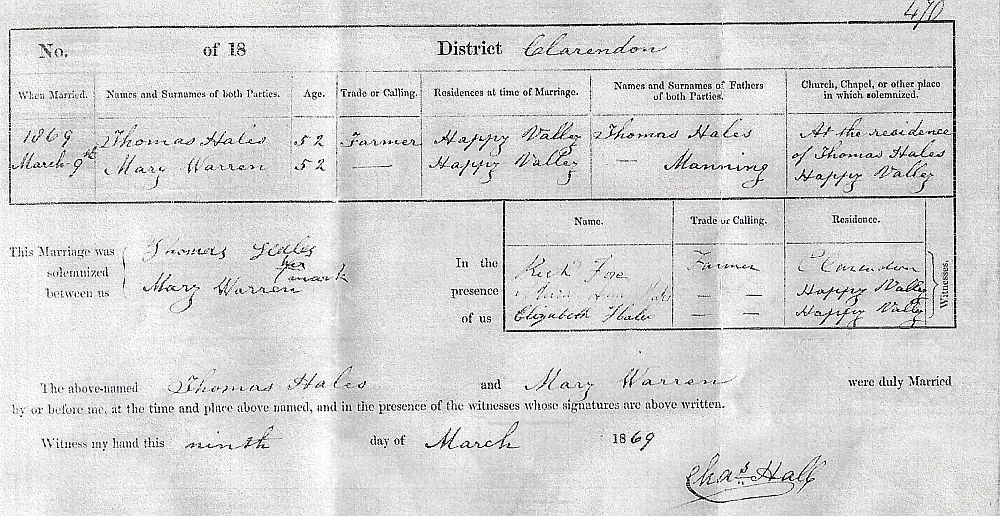
Thomas described himself as a farmer of Happy Valley and he named his father as Thomas Hales. Thomas was literate and signed the marriage certificate whereas Mary Warren signed with a cross. One of the witnesses to the marriage was Thomas’ daughter, Elizabeth Hales.
Mary’s second husband is the same Thomas Hales from whom Mary’s first husband, John Warren, purchased his 6 acres of land back in 1860.
Thomas Hales and his wife, Rebecca, nee Hankins, had arrived into South Australia on board La Belle Alliance from London via Plymouth in July 1947 with their two small children, one of them being Elizbeth Hales. Thomas and his wife had several more children once in South Australia, but Rebecca died after the birth of their eighth child in 1861. Thomas then married again, this time to Mary Rankin, nee Rushton in 1864, but soon Thomas was again a widower, his second wife dying in 1866.
So, in 1869, Mary having been a widow for 2 years, married Thomas Hales and lived with her new husband and his family in Thomas’ house in Happy Valley leaving Oliver in the Warren house on the 6 acres of land.
1869, July – Marriage - Oliver Warren to Elizabeth Hales
Just a few months after Mary’s marriage to Thomas Hales, Mary’s son, Oliver married Elizabeth Hales, the daughter of Mary’s second husband, Thomas Hales on July 21, 1869
Name: Oliver WarrenFather's name: John WarrenSpouse Name: Elizabeth HalesSpouse's Father's Name: Thomas HalesMarriage Date: 21 Jul 1869Marriage Place: Bc Chapel Happy ValleyRegistration Place: Willunga, South AustraliaPage Number: 655Volume Number: 80
Now that Mary was re-married and living with her second husband, Thomas Hales, it is most likely that Oliver brought his bride, Elizabeth to live in the house that his father, John Warren, had built on the land at Happy Valley.By 1875, Oliver Warren had defaulted in repayment of the Bill of Exchange over the Happy Valley land and John Richardson enacted his right to sell the land. He contracted with Oliver to sell the land to Oliver for the sum of £25.
1875, September – Legal Title Transferred to Oliver Warren
Thus, Oliver Warren became owner of the land (the land was part of a larger section originally granted under a land grant in 1839 to Henry Seymour). By September in 1875, legal title of the land now rested with Oliver Warren.
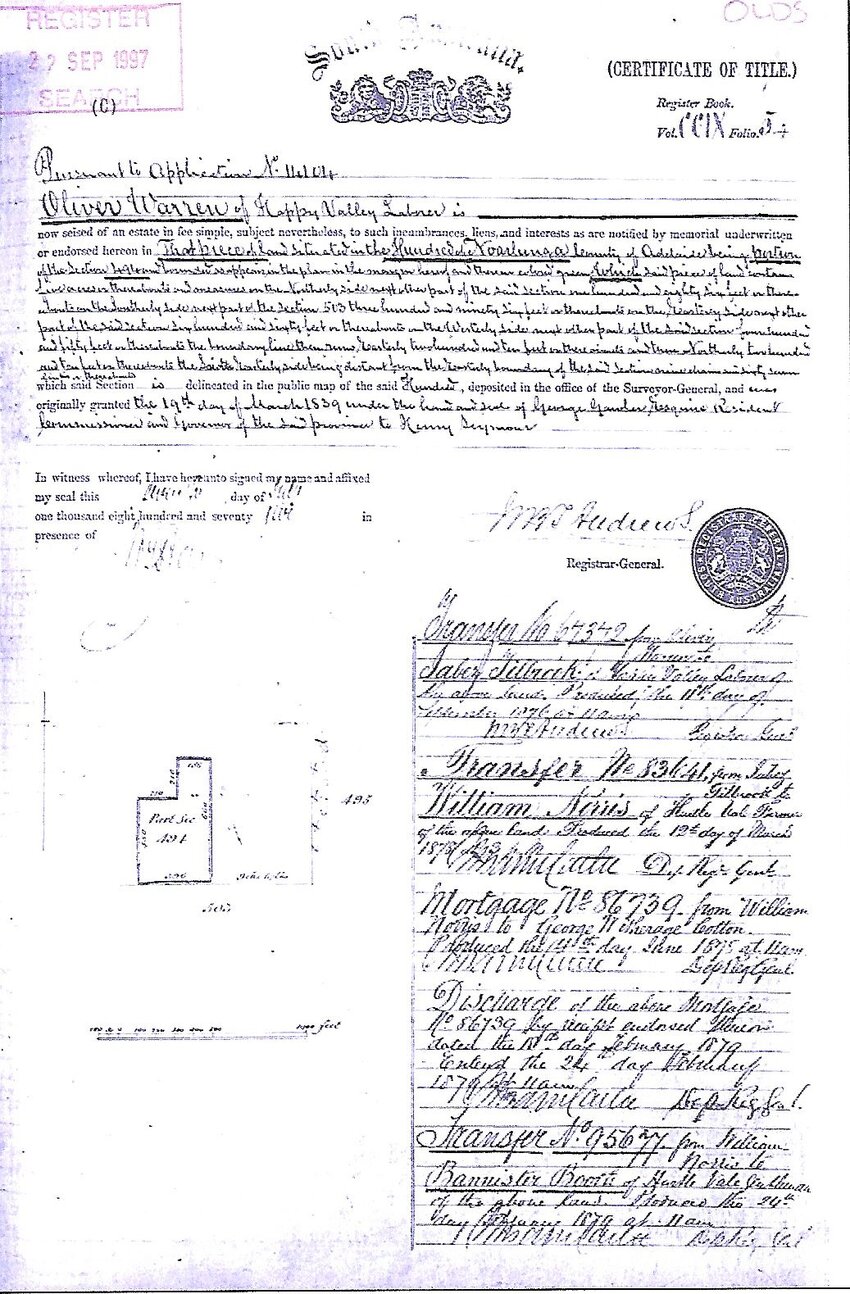
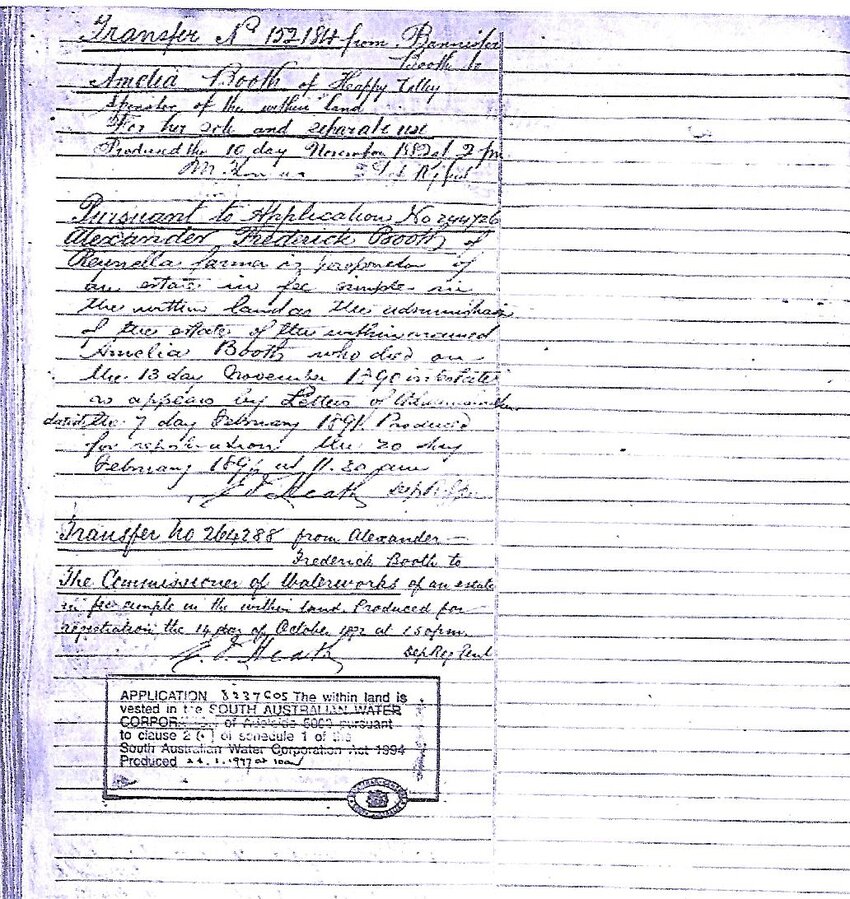
1875 Certificate of Title to Happy Valley Land
It is not clear what the sale price of the Happy Valley land was when Oliver sold it to Tabez Tilbrook. The details of the changes in titles of the Happy Valley land are –
Date Action Details
1850, March 20 Conveyance Hales to John Warren
1850, December 20 Memorandum Agreement John Warren to John Richardson
1875, July 18 Conveyance John Richardson to Oliver Warren
1876, September 11 Transfer Oliver Warren to Tabez Tilbrook
1878, March 12 Transfer Tabez Tilbrook to William Norris
1878, June 14 Mortgage William Norris to George Witherage Cotton
1879, February 24 Discharge of Mortgage
1879, February 24 Transfer William Norris to Bannister Booth
1882, November 10 Transfer Bannister Booth to Amelia Booth
1891, February 7 Transfer under Estate Amelia Booth (deceased) to Alexander Frederick Booth
1892, October 14 Transfer Alexander Frederick Booth to The Commissioner of Waterworks
1875, October – Death -Thomas Hales
On October 7, 1875, Mary’s second husband, Thomas Hales, died at Happy Valley. The newspaper The South Australian Register of November 6, 1875, reported that he died after a lingering illness. He was buried in the original Happy Valley Cemetery, not far from John Warren.
Name: Thomas HalesBirth Year: abt 1817Age: 58Death Date: 07 Oct 1875Death Place: Happy ValleyResidence Place: Happy ValleyRegistration Place: Adelaide, South AustraliaPage Number: 163Volume Number: 69Source: Ancestry.com. Australia, Death Index, 1787-1985
1876, July – Marriage of Mary Hales to James Henry Smith
Mary (nee Manning, aka Mary Warren, aka Mary Hales) a widow after the death of her second husband, married again on July 22, 1876. She married James Henry Smith at a service held in the Adelaide Registry Office. Mary, this time as Mary Hales, was 60 years old and a widow and her new husband, 65, was a widower. James was a carpenter living in Brighton – his father was given as James Smith. Mary was described as a widow living in Sturt. James signed the marriage certificate with a strong well-formed signature. Mary signed with a cross. Mary identified herself as ‘our Mary’ by providing her father’s name – James Manning.
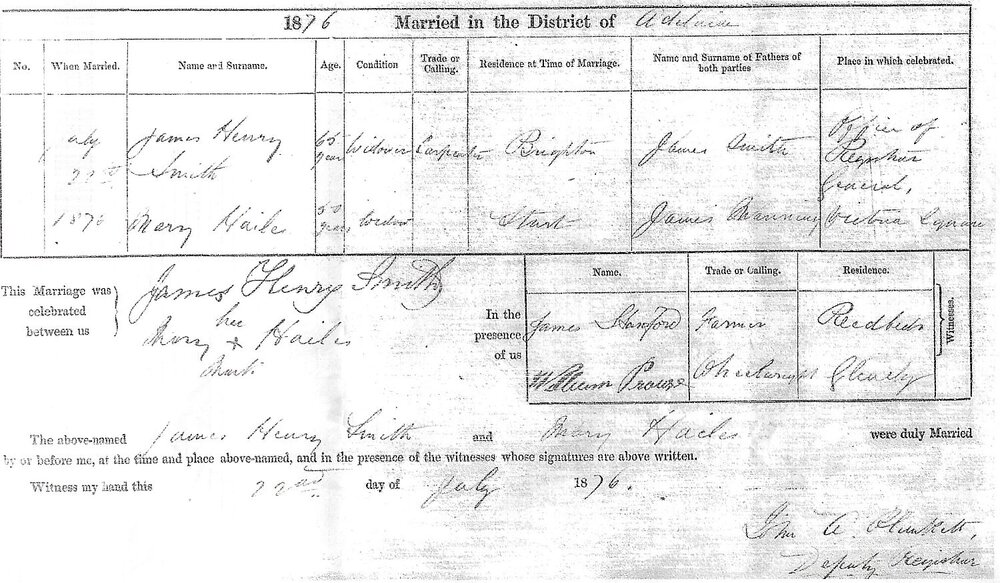
Witnesses to her marriage to James Smith were a farmer and a wheelwright by the names of James Stanford and William Prowse. Did any members of her family attend her wedding?
1876, August – Marriage -Sarah Jane Warren to John Christie
Sarah Jane Warren, Mary’s youngest daughter, aged 19 years, married John Christie on August 8, 1876. They were married at the home of Richard Appleton, their brother-in-law and witnesses to their marriage were Sarah’s brother, Charles Warren and Alice Chase, Sarah’s sister-in-law of Happy Valley.
It was around this time that Charles James Warren, Mary’s youngest son found employment in the baking business working as a baker in Glenelg, South Australia.
Name: Sarah Jane WarrenFather's name: John WarrenSpouse Name: John ChristieSpouse's Father's Name: Alexander ChristieMarriage Date: 05 Aug 1876Marriage Place: Res Of Richard Appleton Happy ValleyRegistration Place: Morphett Vale, South AustraliaPage Number: 422Volume Number: 108Source: Australia, Marriage Index, 1788-1950 www.ancestry.com
1878 – Death - James Henry Smith
Unfortunately, Mary’s marriage to James Henry Smith was not to last long as James Smith died just 2 years later on June 13, 1878 at Brighton, South Australia.
Name: James Henry SmithBirth Year: abt 1807Age: 71Death Date: 13 Jun 1878Death Place: BrightonResidence Place: BrightonRegistration Place: Adelaide, South AustraliaPage Number: 171Volume Number: 88Source: Ancestry.com. Australia, Death Index, 1787-1985 [database on-line]. Provo, UT, USA: Ancestry.com Operations, Inc., 2010.
1879 – Marriage - Charles James Warren to Agnes McNay
In 1879, Mary’s youngest son, Charles James Warren, married Agnes McNay in the dwelling house of Mr. G. McNay, of Staplehurst. George McNay was Agnes’ brother. Both Charles and Agnes gave their residence at the time of their marriage as Edwardstown and Charles gave his trade as baker. Both Charles and Agnes signed the marriage certificate. I wonder if Mary was present at their wedding?
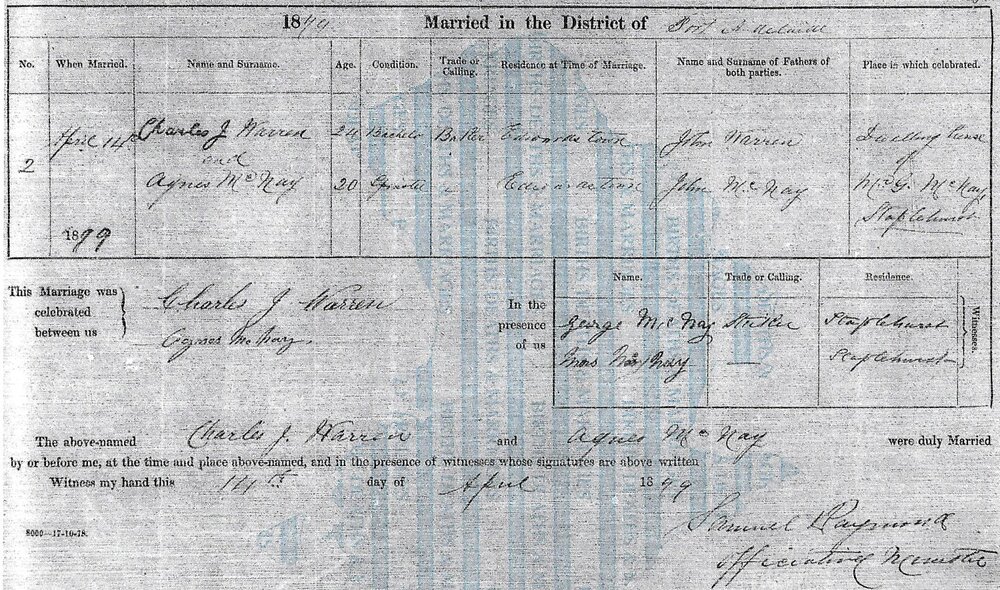
1881 – Marriage -Mary Smith to Isaac George Gray
Remember there was no such thing as a widow’s pension and limited government help at that time. Mary was not entitled to own property so would have received nothing from the estate of her husband, James Henry Smith, so at the age of 64 years, Mary was to marry again.
Mary’s fourth husband was Isaac George Gray who was no doubt lonely and in need of someone to help with his children. His first wife, Sarah had died in 1875. After three years of being a widower, Isaac had then married his second wife in 1878 (Harriet May Coote, nee Dare). She brought with her to the marriage her 10 children, but she died early in 1880. So, after ten months on his own again, Isaac proposed marriage to our Mary, widow of John Warren, Thomas Hales and James Henry Smith.
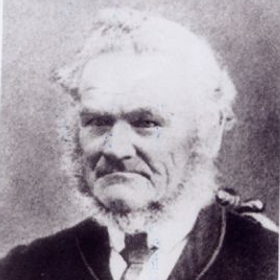
Isaac George Gray
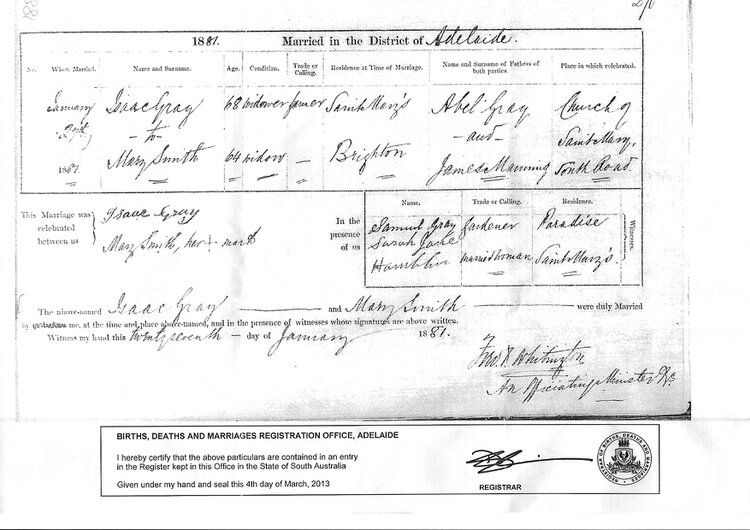
The marriage certificate gives their ages as Isaac 68 years and Mary 64. Isaac was a farmer. His father was Abel Gray. Mary Smith (our Mary) was living at Brighton where she had lived with her last husband, James Henry Smith.
Isaac’s personal description – four feet ten inches tall, grey eyes, fair hair, gunpowder mark on left side upper lip.
Isaac was living in Port Elliott and the story goes that he walked over the hills to Mary’s residence with his wheelbarrow to collect Mary’s very few belongings, returning to Port Elliott where they married.
Their marriage was performed at St. Mary’s Church of England on South Road, Sturt, South Australia on January 27, 1881. Witnesses to their marriage were certainly many members of Isaac’s large family – Isaac’s son, Samuel was the best man and signed the marriage certificate as a witness. Remember that Samuel Gray was the young man who had travelled with John and Mary Warren and their children from England on the ship Reliance back in 1851.
Isaac’s daughter, Sarah Jane Hamblin was Mary’s matron of honour. It is not clear whether any of Mary’s family attended her fourth marriage. Samuel gave his occupation as a gardener living in Paradise, a suburb of Adelaide. Isaac signed the marriage certificate with a heavy and cramped signature and again, Mary signed with a cross.
A reception followed the marriage at the Lady McDonald Hotel which at that time was managed by Isaac’s daughter, Sarah and her husband.
Mary’s life with Isaac must have been busy caring for the many children that were still living at home. Just how many of Isaac’s children from his first marriage and his second wife’s children were still at home is unclear, but there must have been quite a mob of hungry mouths to feed, clothe and look after.
Isaac on the other hand probably had a little more spare-time and as he was a gardener, he started growing grapes and making wine, which he sold for one penny a glass.
1895 – Death - Isaac George Gray
Fourteen years later, Mary’s fourth and last husband, Isaac Gray died on June 16, 1895 at Port Elliott, aged 83, leaving Mary a widow again. But even after fourteen years of marriage to Isaac Gray, Mary was not recognized on Isaac’s headstone which is in St. Jude’s Church of England Cemetery at Port Elliott. Only Isaac’s first wife, Sarah, who had died some six years prior to Mary and Isaac’s marriage is remembered and one of their daughters.
Name: Isaac GrayBirth Year: abt 1812Age: 83Death Date: 16 Jun 1895Death Place: Port ElliotResidence Place: Port ElliotRegistration Place: Encounter Bay, South AustraliaPage Number: 351Volume Number: 227Source: Ancestry.com. Australia, Death Index, 1787-1985
1897 – Mary Admitted to Destitute Asylum
Mary was 76 years old when Isaac died in 1895. By 1897 she had been a widow for 2 years and in that period, had lived alternatively with her daughters Emma (Mrs. Chase) and Charlotte (Mrs. Appleton). On April 15, her daughter, Emma Chase, with whom she had been lately living, applied to have her admitted to the Destitute Asylum in Adelaide. In response to the question about her relatives, Emma answered –
Widow 2 years. 4 children. Charlotte Appleton, married, no children, Reynella. Emma Chase, 50, married, 3 children, Happy Valley. Oliver Warren, 48, Widower, 8 children, aged 23 to 9 years, Blumberg. Charles Warren, 37 married 6 children in Victoria.
The Board of the Asylum agreed to admit Mary and gave these reasons –
Suffering from old age and infirmity and for the last two years she has made her home alternately with her daughters Mrs. Appleton and Mrs. Chase. They have refused to help her any longer and her son in Blumberg is reported to be in poor circumstances. She has a life interest in a cottage at Brighton of trifling value left her by James Smith, a former husband, who was a blacksmith at Brighton and died about 10 years ago.
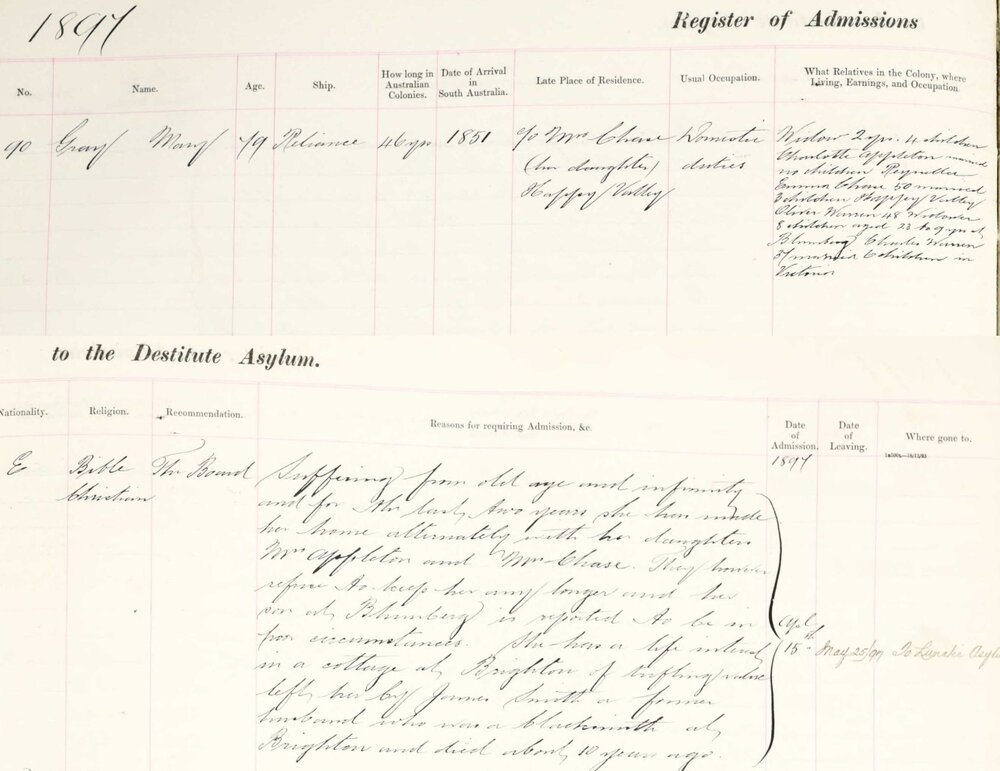
1897 – Excerpt from Register of Admissions to Destitute Asylum
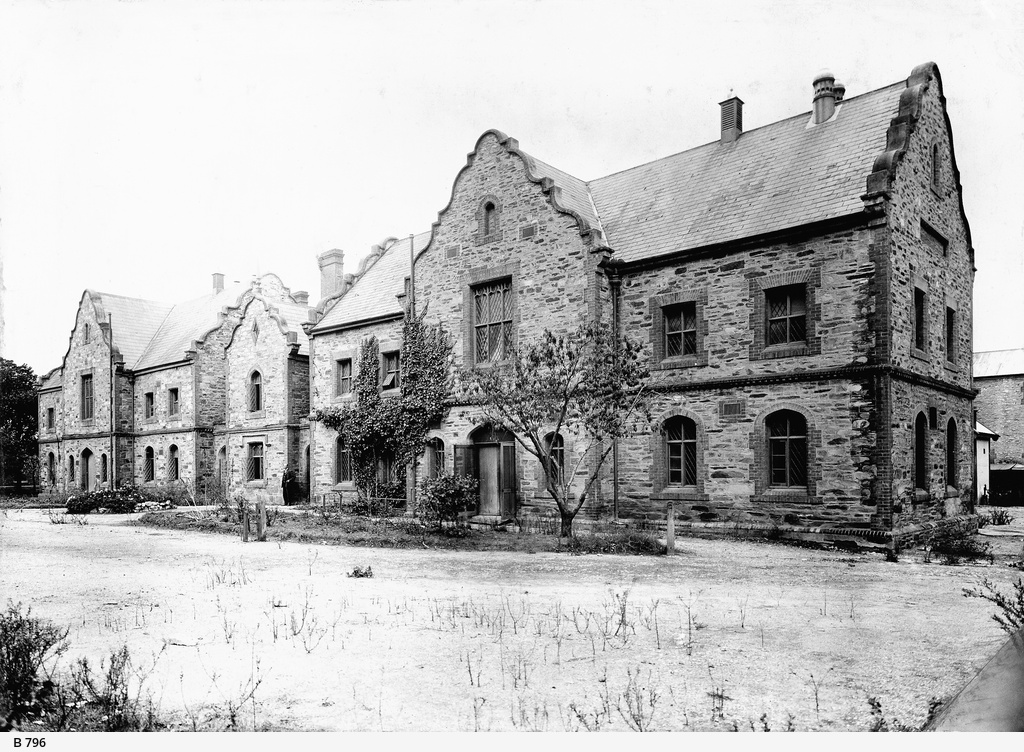
Adelaide Destitute Asylum
Mary would have been outfitted with the standard Asylum Uniform – a severe blue-grey dress with a white apron. The dress was standard issue and would have been made by fellow inmates,
The Asylum bell regulated her life. It rang for getting up, breakfast, lunch and dinner and lights-out. Able-bodies women spent their time washing and mending bed linen and clothing of other inmates or working in the kitchen.
The Asylum was a far from attractive place. It was a separate institution where the poorest and most dependant could be regulated and kept hidden away from Adelaide’s respectable citizens. To keep numbers and cost down the Asylum, with its high stone walls, poor accommodation, and many regulations, was meant to be a place of last resort. Men and women were segregated by a stone wall of nearly three metres high. Mary would have been permitted to leave the Asylum once a week for a few hours, but she possibly stayed inside the walls because her uniform labelled her as an Asylum inmate.
For breakfast and the evening meals the inmates ate dry bread and drank tea. For lunch they were served vegetable soup, boiled mutton, and potatoes. There were vegetables other than potatoes twice a week. An excellent description of life and conditions is contained in Mary Geyer’s book Behind The Wall – The Women of the Destitute Asylum Adelaide, 1852 – 1918.
1897 – Mary Transferred to Lunatic Asylum
Mary’s mental health must have re-assessed because Mary was transferred to the North Terrace Lunatic Asylum on May 25, 1897. This was possibly an even more hideous place than the Destitute Asylum. In those days, she would have qualified for admission to such a place simply because she was suffering from some degree of senility.
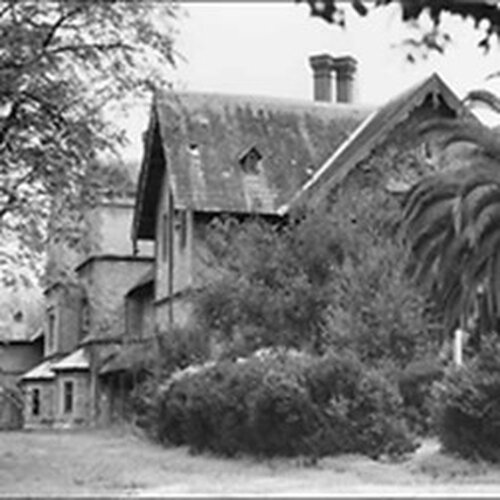
North Terrace Lunatic Asylum
1899 – Death - Mary Manning
Mary died there on September 28, 1899 aged 81 years. Her cause of death was noted as cerebral softening from which she had suffered for about 2 1/3 years and senile decay.
Senile decay refers to the progressive loss of mental capacity that leads to dementia and personal helplessness. Most of the cases recorded as senility at that time were most likely Alzheimer’s disease.
Sadly, it appears that Mary may have been deserted by her family as other than the word “widow” there is a notation “nothing further known” recorded on her death certificate. No one other than the local undertaker noted her passing and Mary faded from our world.
And to add to the ignominy, Mary’s body was bundled up and joined the other many Asylum inmates who were buried at the government’s expense in simple coffins in unmarked graves in common ground at the West Terrace Cemetery.
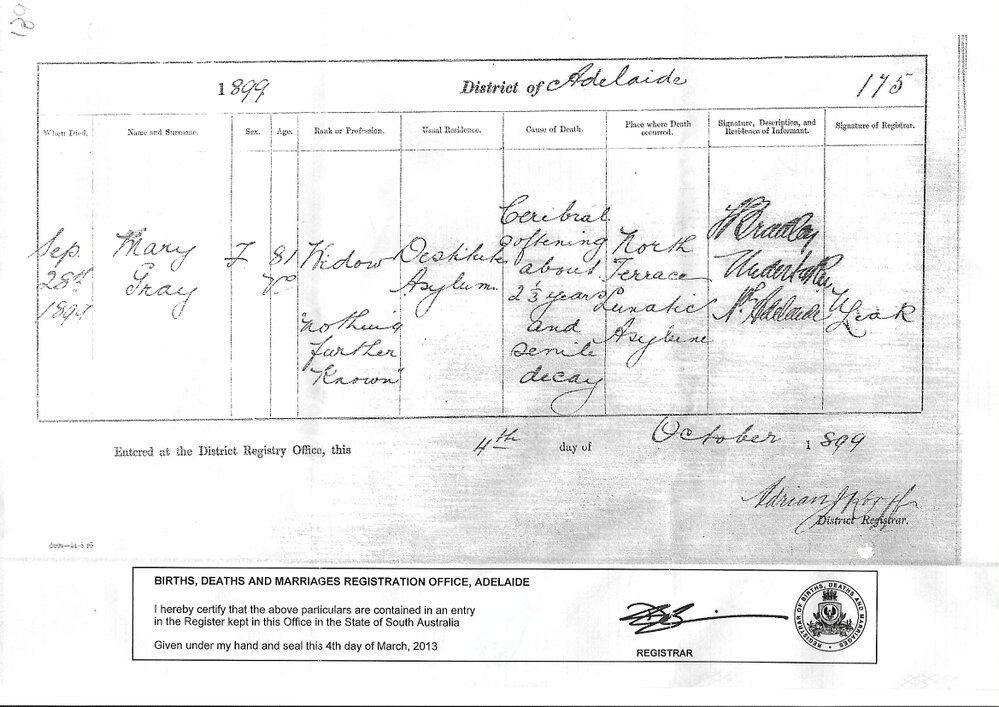
1899 Death Certificate - Mary Gray at Destitute Asylum, Adelaide, SA
How much more colour could Mary have imparted to her story if she could have spoken or left some written word – or if we even had a photograph of her.
Mary Manning and John Warren were my ancestors – and I remember them.

